
Bayside Neighborhood self-guided history tour
Everett, Washington
The neighborhood
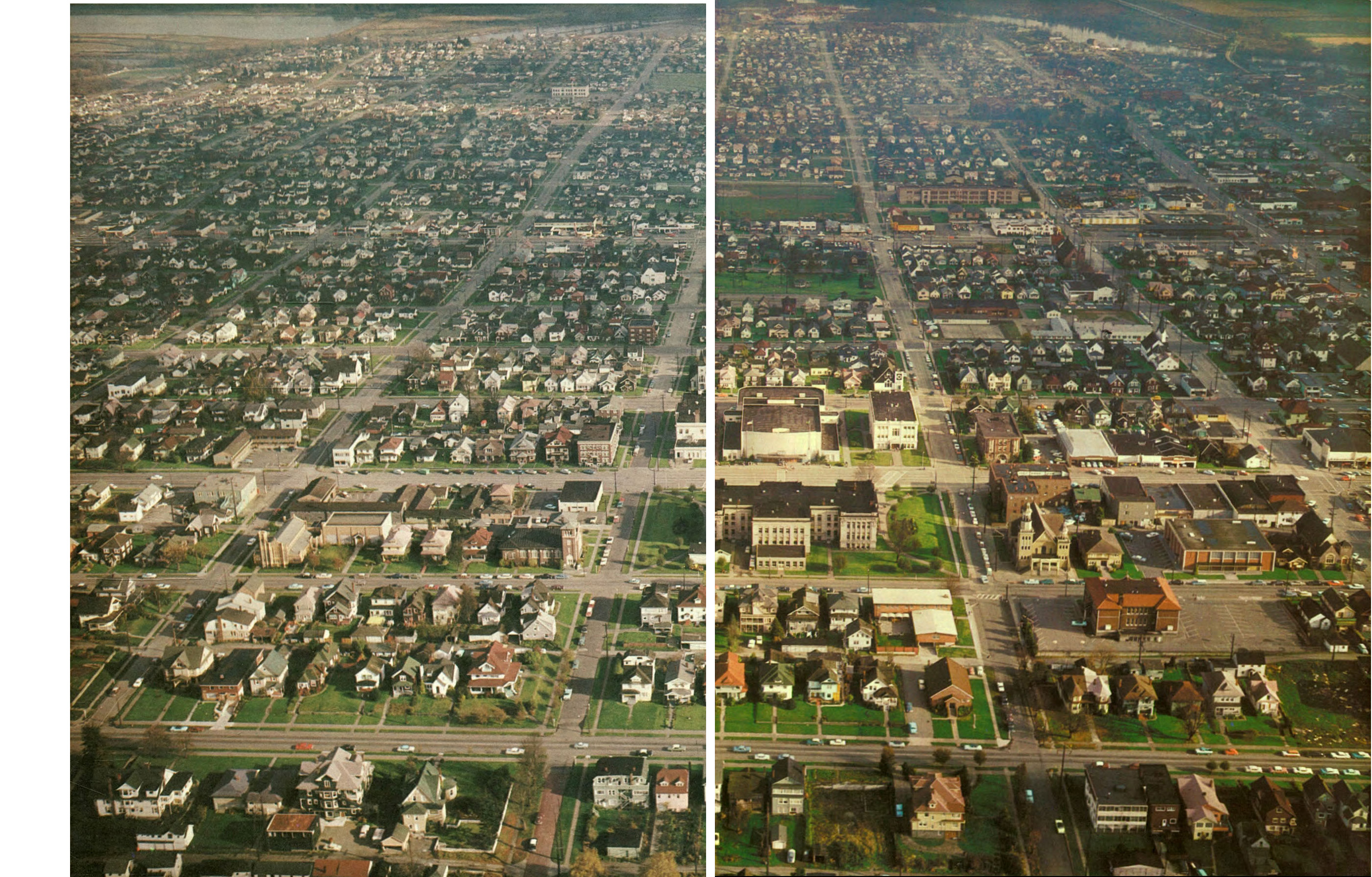
Welcome to Bayside Neighborhood! The boundaries for this website exclude the central business district. We include from Everett Ave to 19th St, and west of Broadway Ave.
Streets Index
Pick a street of interest, and while walking compare the old photographs with today.
Note: for more Everett neighborhoods, see the tours page.| E-W | N-S |
|---|---|
| 19th St | Grand Ave |
| 20th St | Rucker Ave |
| 21st St | Hoyt Ave |
| 22nd St | Colby Ave |
| 23rd St | Wetmore Ave |
| 24th St | Rockefeller Ave |
| 25th St | Oakes Ave |
| 26th St | Lombard Ave |
| Everett Ave | Broadway Ave |
Parks Index
19th St
Fred Harlan house, a house moved ()
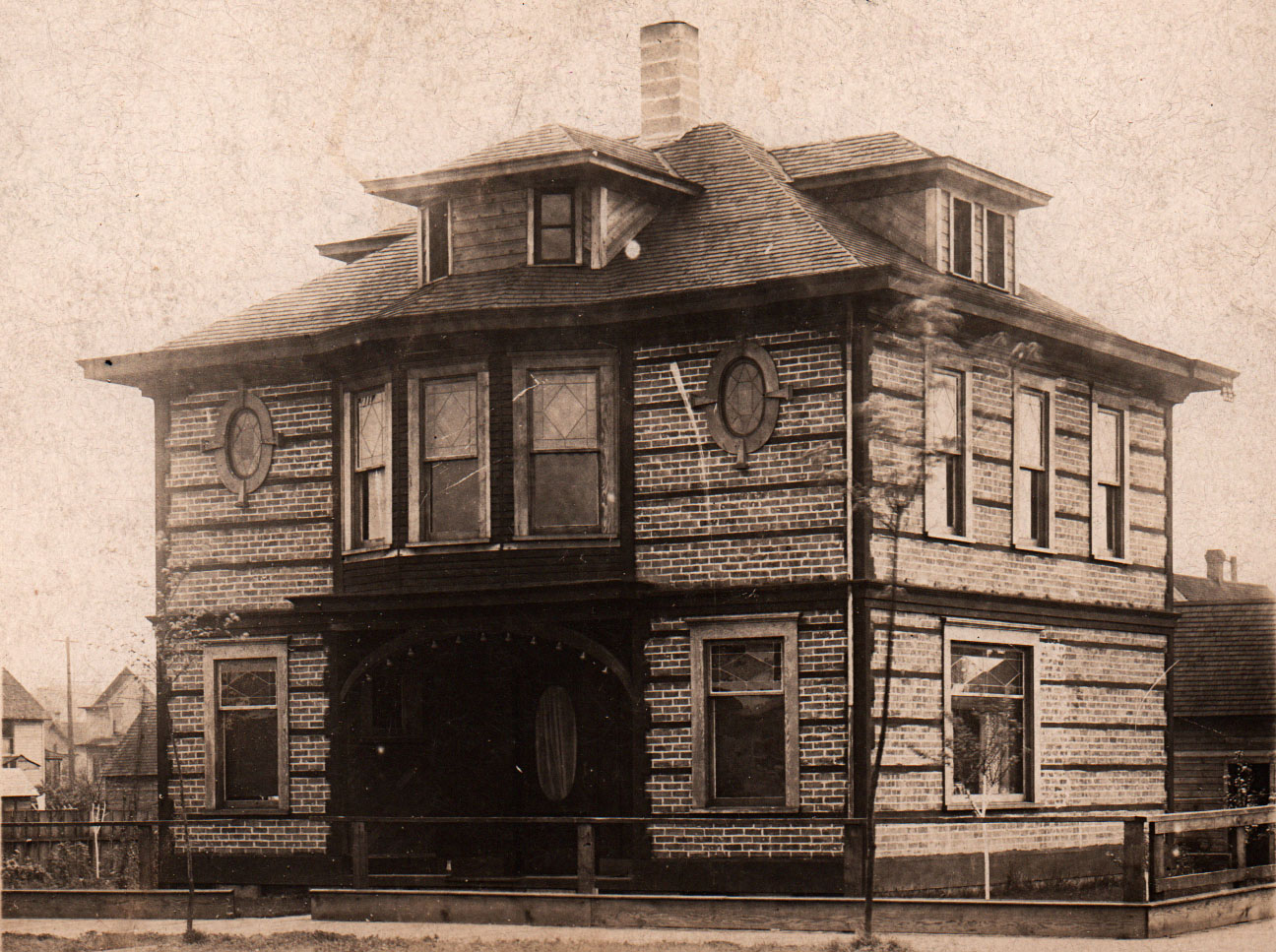
This house was built at 1902 Lombard. The lot was split and the house shifted back to the alley. The front door was moved to the 19th street side. The dormers and bay windows are gone. The 1902 Lombard one sees there now, was built on the open foundation, perhaps in 1914. Sanborn maps indicate the house may have been moved between 1914 and 1955, when the maps were redrawn. There are no water and sewer records for new 1902, apparently since the foundation already had them from long before. The city's water records for the first 1902 show the name Rucker Brothers, at Nassau and Hewitt, as owners. Dave Ramstad research Fred Harlan was a wireman at Everett Railway, Light and Water Co. (the trolley company among others).
23rd St
First Christian Reformed Church/Holland
This was used as a church from 1917-1953. The congretation moved to 15th and McDougal. Now it's a private residence.
24th St
25th St
26th St
Raymond Fosheim House (1892)

Everett Ave
Grand Ave
Fire Station No. 3 (1909)
Everett's original Fire Station No. 3 still stands, although it's hard to tell it was once a fire station. Built in 1909, it remained in service as a fire station until 1927, when a new station was built below the bluff at 1701 Norton (now Marine View Dr). (That second station remained until the 1970s, when it was moved to Vashon Island. It was replaced by a third Station No. 3 at 920 13 St. The third station was closed and demolished in 2006. The city bought property for a new Station No. 3 at 26th and Marine View Dr. in 2009, but was not built as of 2021.)
William Cleaver/HJ Clough house (1907)
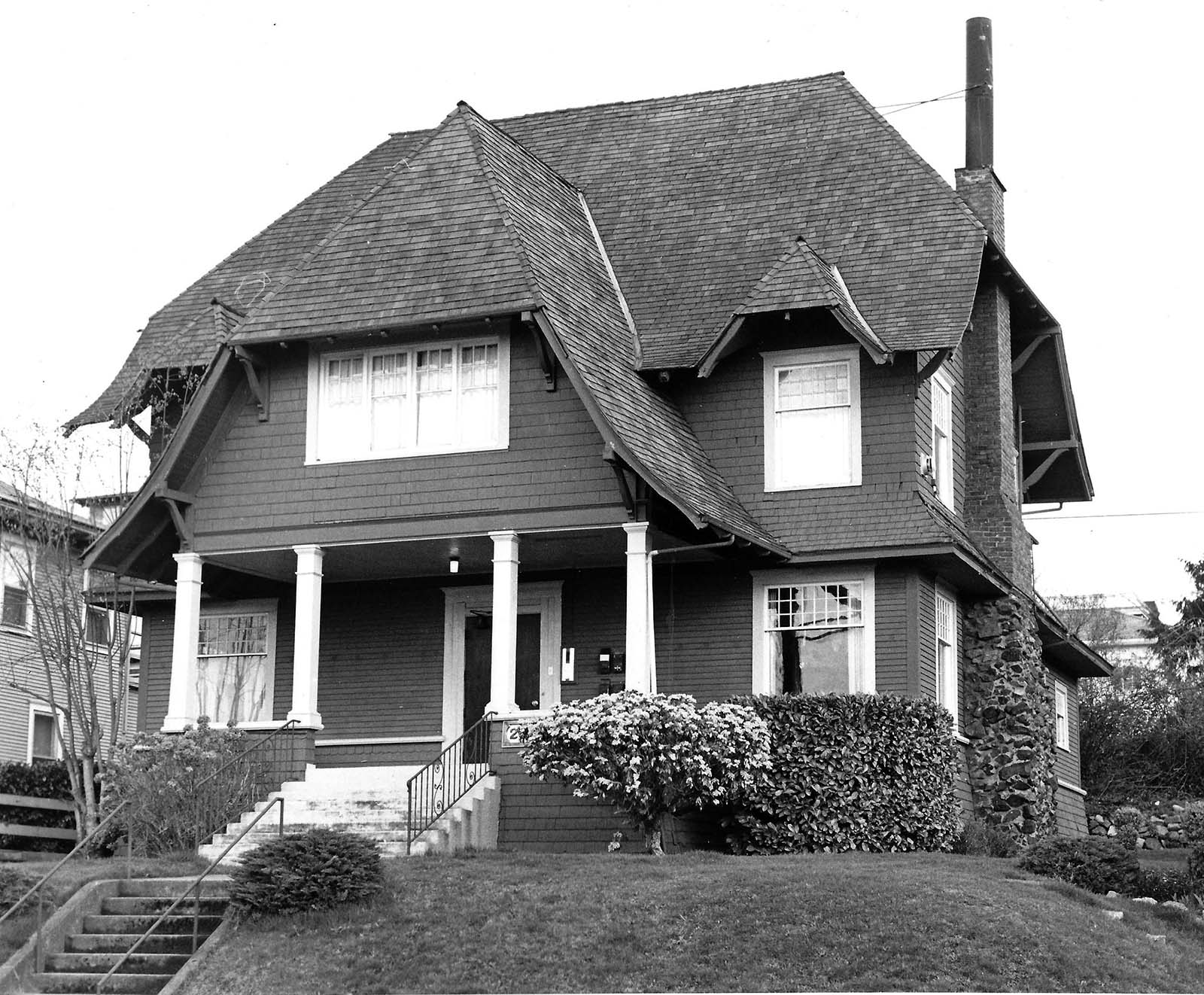 Everett Public Library archives
Everett Public Library archives
This Swiss chalet-looking house is an outstanding example of the Craftsman style. Observe the wide open eves with knee brace decorations, fish scale shingle, and clapboard siding.
William Cleaver (born 1871) owned a successful dry goods and ladies clothing store at Hewitt and Rockefeller Avenues, and was director of the Everett Chamber of Commerce. He moved to Port Clinton, Ohio from Hanover, Germany at age 14. Some architectural features of this Shingle style house may reflect his heritage. After working as a clerk in Butte, Montana from 1895-97, he moved to Washington state. After a few years in Spokane and Oakesdale, he moved to Everett in January, 1902.
The house was sold just a few years after it was built to H.J. Clough, who moved from 1917 Rucker. He was president of the Clark-Nickerson Co, one of Everett's large sawmills with 300 employees. He was also president of the Barnet Lumber Co. in Canada, the Clough Lumber Company in Stanwood, the Clough Shingle Company in Everett, and the Hama-Hama Logging Company on Hoods Canal. Total for all these companies was 685 men. He was also on the board of directors of First National Bank. Clough was one of the strongest individual forces in the development of Washington's great lumber instrury.
Beginning in the 1920s, the house was owned by Clayton M. Williams, attorney and first president of the Rotary Club. He was in it for a couple decades. Later on, the house was broken up into apartments. In recent years, Craig and Carolyn Parker restored it back to a single family home. The house is on the Everett Register of Historic Places.
The Shingle style was popular between the 1880s and 1900, with a few examples up to 1910. It was a uniquely American adaptation of other traditions, mostly a high-fashion architect's style rather than widely adapted to vernacular housing.
Everett Herald article, May 3, 2009. See also Jan 30, 1943 article and photo from Everett Herald, sale to Mr. and Mrs. Frank McGuire.
 Jack O'Donnell collection
Jack O'Donnell collection
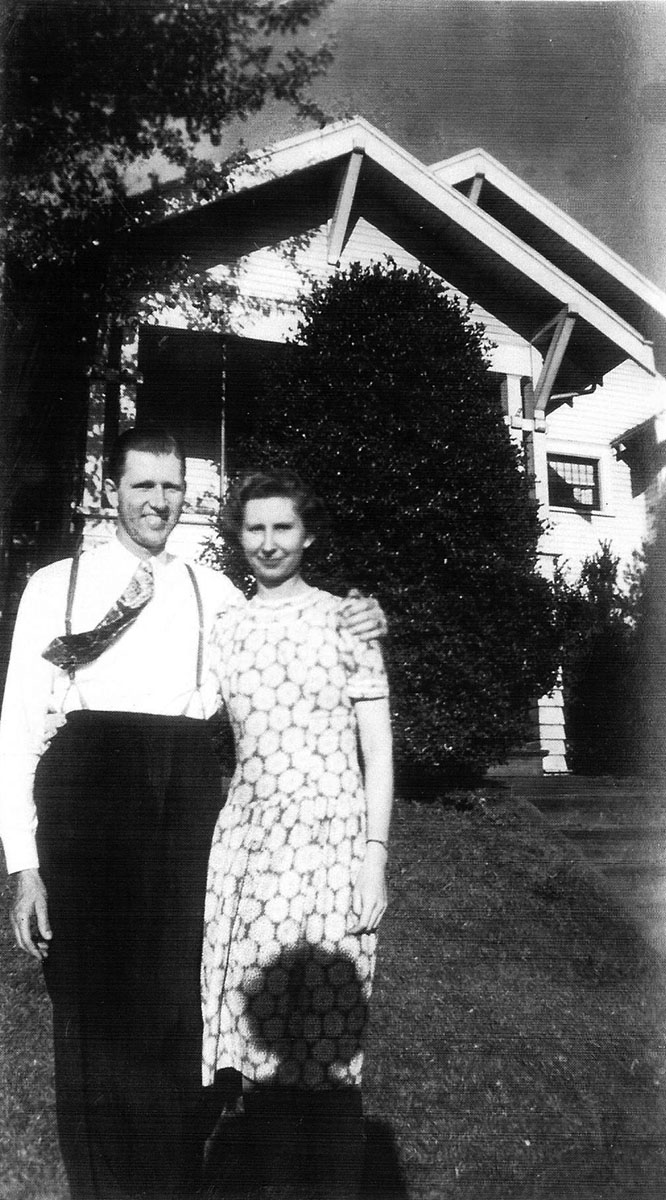 Circa 1930s or 1940s.
Jack O'Donnell collection
Circa 1930s or 1940s.
Jack O'Donnell collection
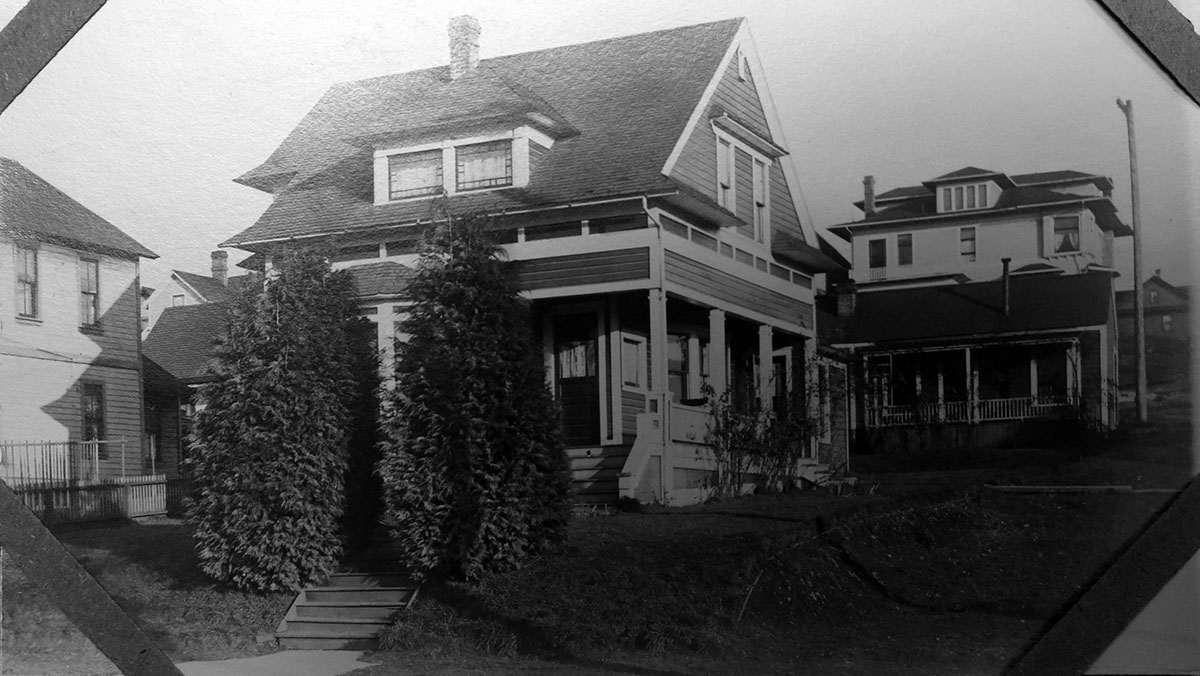
Andrew Thorsvig house (1899)
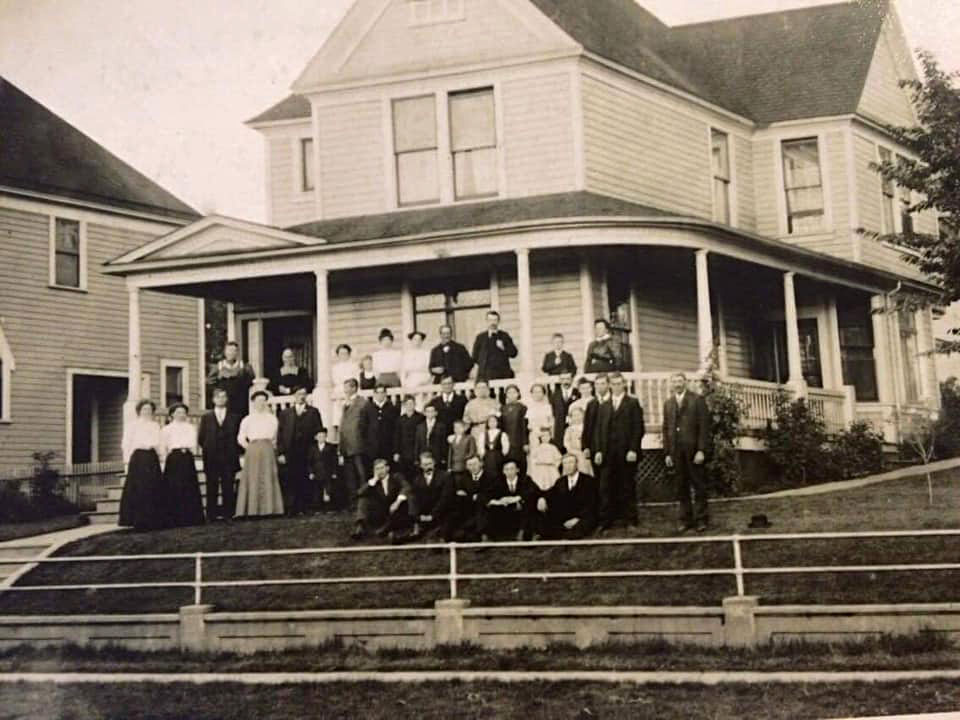 1901.
Alexis Tobin collection
1901.
Alexis Tobin collection
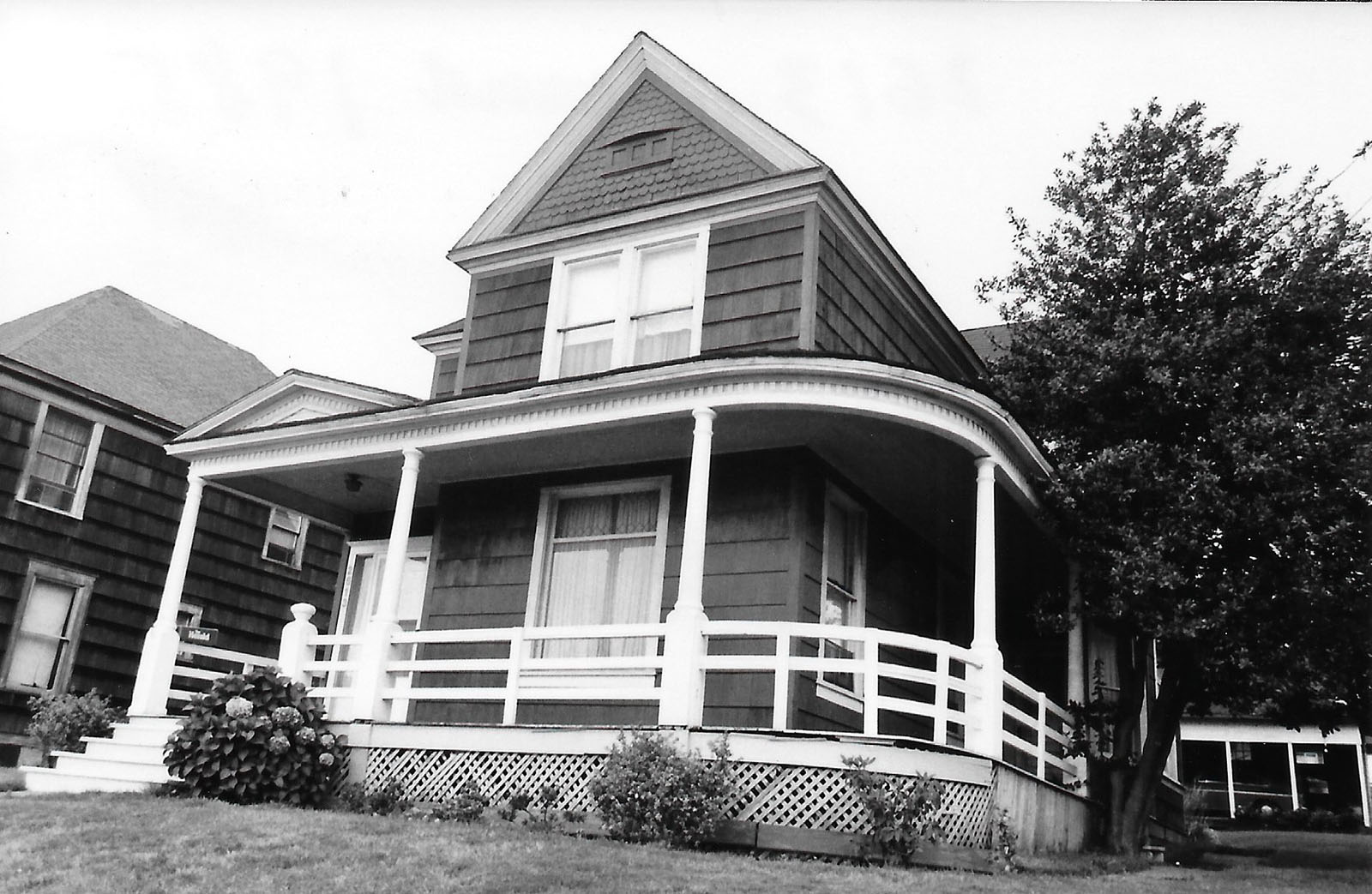 1985.
Phyllis Royce
1985.
Phyllis Royce
There's an ad for Andrew Thorsvig at this address in the 1907 Polk Directory, "General Contractor, Grading and Excavating, Estimates Furnished".
Charles Miley house
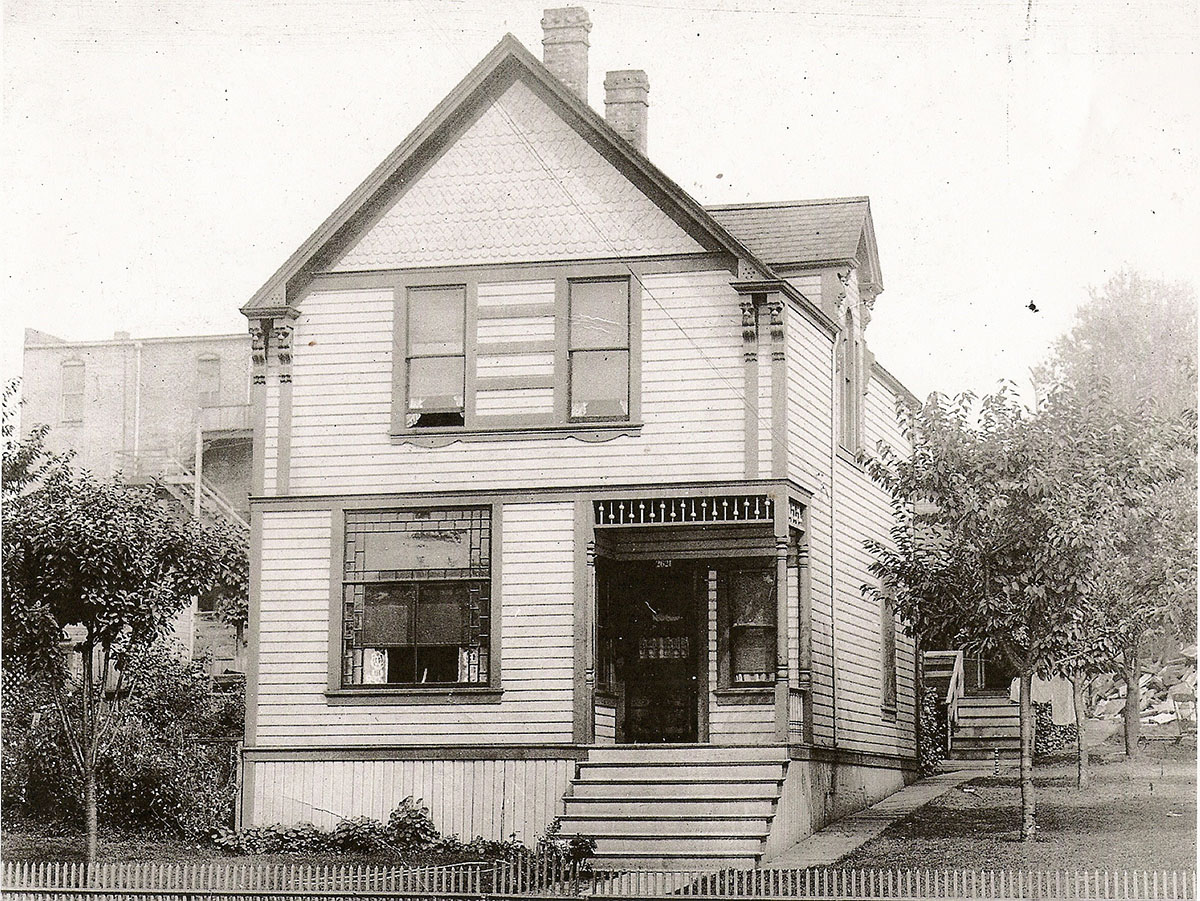 This 1890s house has been picked up and turned to face south.
Jack O'Donnell collection
This 1890s house has been picked up and turned to face south.
Jack O'Donnell collection
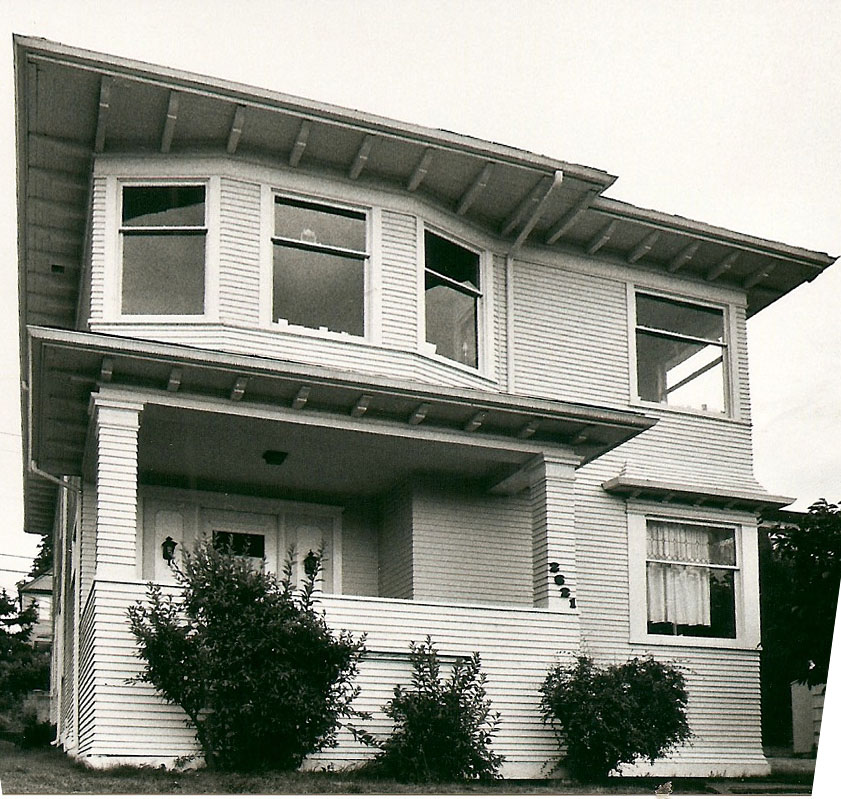 They added what you see on the front to make a much larger house.
The house has incredible woodwork and staircase inside -- absolutely beautiful.
Jack O'Donnell collection
They added what you see on the front to make a much larger house.
The house has incredible woodwork and staircase inside -- absolutely beautiful.
Jack O'Donnell collection
Charles Miley was a partner with the Rucker Brothers in 1914. They entered a bid to obtain a 10 year contract to log on the Tulalip Indian Reservation. However, the Hartley and Everett Logging got that contract. There is a Miley building on the 1700 block of Hewitt on the south side.
Rucker Ave
John and Sophie Sittig house (1893)
John F. (teamster) and Sophie M Sittig lived here a short time when the house was new. Apparently he kept two horses in the front yard. Paul F. (gardner) and Mary Shlessger lived here 1928-38. Their daughter Lillian Shlessger was a stenographer. John A. (millworker, logger, electrician) and Agnes C. Wenzlick lived here 1938-56.
David Clough house (1900)

David M. Clough, who was governor in Minnesota and a lumberman there, moved to Everett. He owned the Everett Logging Company, Clark-Nickerson Mill, and the Clough-Hartley Mill on the Everett waterfront. He and wife Addie, moved here in 1905. Roland Hartley (later a governor of WA) and family boarded here from 1905-08. The house was vacant for about ten years in the 1920s, then converted to apartments. See 1907 Coast magazine for picture.
Marlborough Apartments (1912)
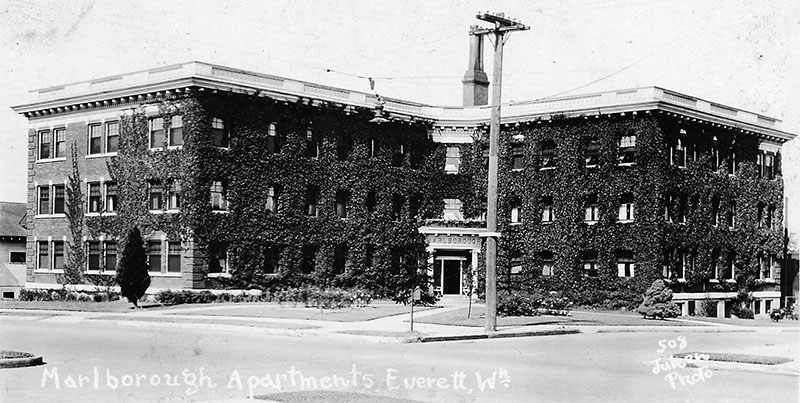
Built for James E. Gowen, by 1915 it was owned by Theron A. Noble. This elegant Tudor style apartment building displays classical lines and exceptional craftsmanship. It shows the possibilities for density while maintaining open space and an orientation to the street and the neighborhood. It was often the home of teachers and retired prominent citizens, such as William Swalwell, Eugene Metzger and Robert Moody, Eslie Walton of Walton Lumber, Fred Baker of Baker Lumber Co., Thomas Hartley related to Governor Hartley. It has 18 apartments, including 2 studios in the basement which once served as quarters for servants of affluent tenants. Permits were issued in 1918 for an 11 car garage, and 1936 for additional cars.
See January 17, 1931 Herald "$100,000 Worth of Building and Land is Traded", where Theron Noble traded to Bell Fifth Ave Co. for a business lot in the the Denny Regrade part of Seattle, for $50,000. In 1935, Prudential Insurance bought it through a Sheriff's sale. Owned by the William and Helen Johnston family from 1976 for at least 30 years.
(1907)

This house was built for Goddard as an investment property, together with 2115 and 2121 Rucker. These are all classic American Foursquare homes.
John J. Clark House (1895 or 1896)
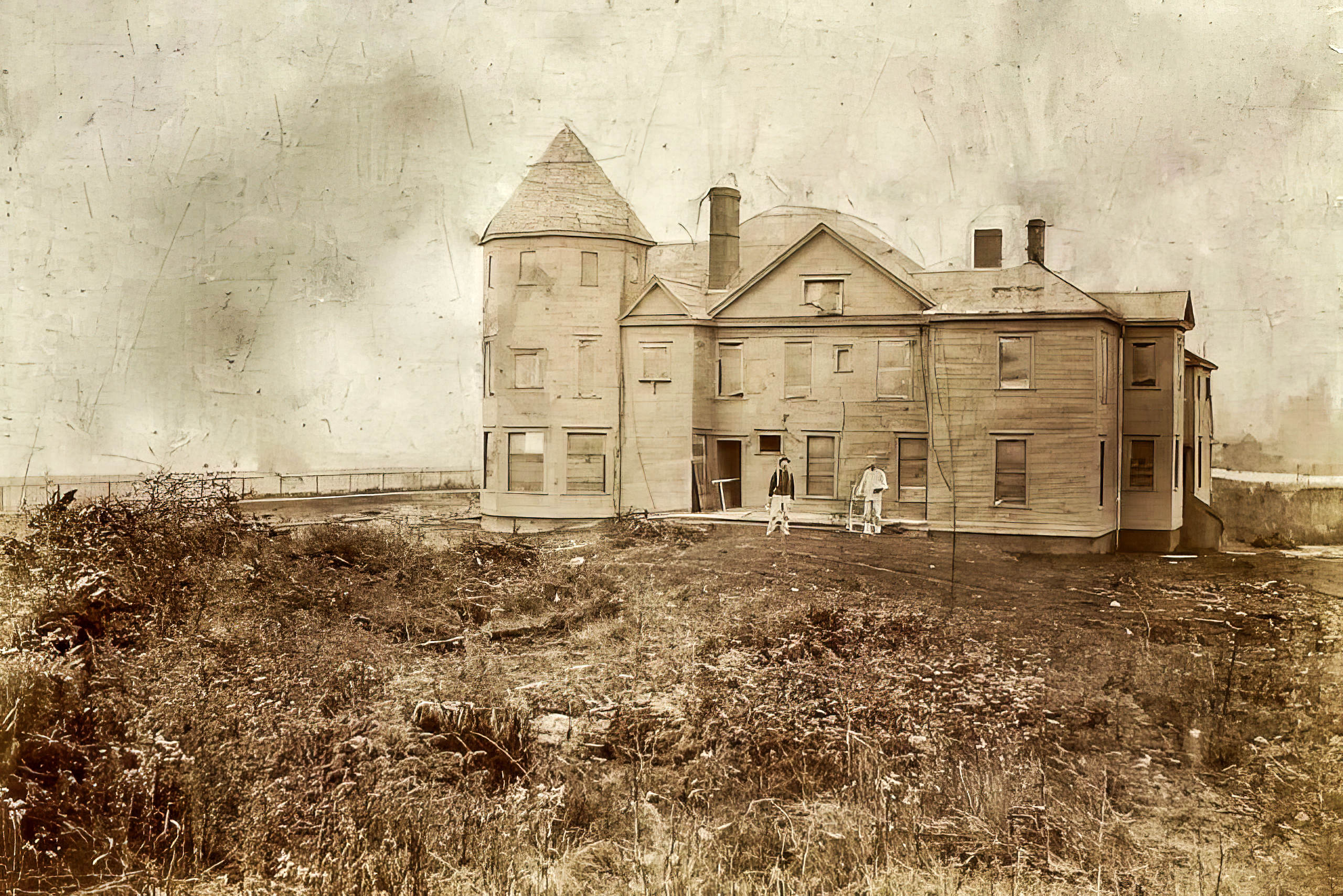
Designed by A.F. Heide
Built for the prominent businessman J.J. Clark. Clark was one of the founders of Everett and highly regarded, and president of Clark Clothing Co. His family lived here from 1895-1922. Clark's name is immortalized by the downtown park. Dorcas Clark took over management of Clark Investment Co. when her father died. A formal Queen Anne house with asymmetrical composition and a variety of roof styles, but free of ornamentation. In 1927 the house was converted to apartments.
Per Dallas Lincoln Salisbury: Great Grandfather John Judson Clark arrived in Everett in 1891 to open the first dry goods store. Following his death the City named Clark Park in his honor. He build a home at what is now 2129 Rucker in 1894 before Rucker Avenue and the north end were leveled. As a result 2129 now appears to have been built on top of a small hill, when in fact it was build at ground level. His daughter, my grandmother, Margaret Clark Salisbury, was the first graduate of Everett High School in 1891. The home is no longer in my family, but is owned today by an EHS graduate, keeping it in the extended family, so to speak.
W.P. Bell/Elm house (1898)

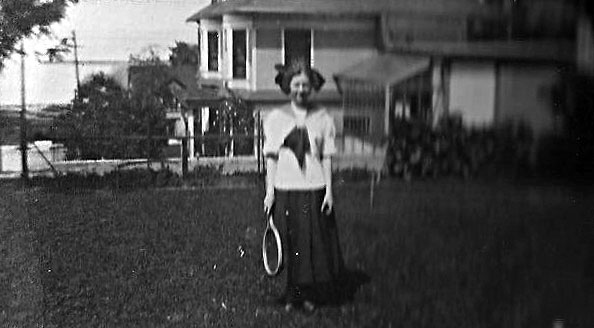
This was the home of Walter P. Bell, wife Lillian (Blackman) Bell, and children Doris, Winnifred, Mary and Harold. Bell was a prominent attorney, and a partner with Austin. The family occupied the house thru the 1930’s at least. Much later this became the Elm House Apartments.
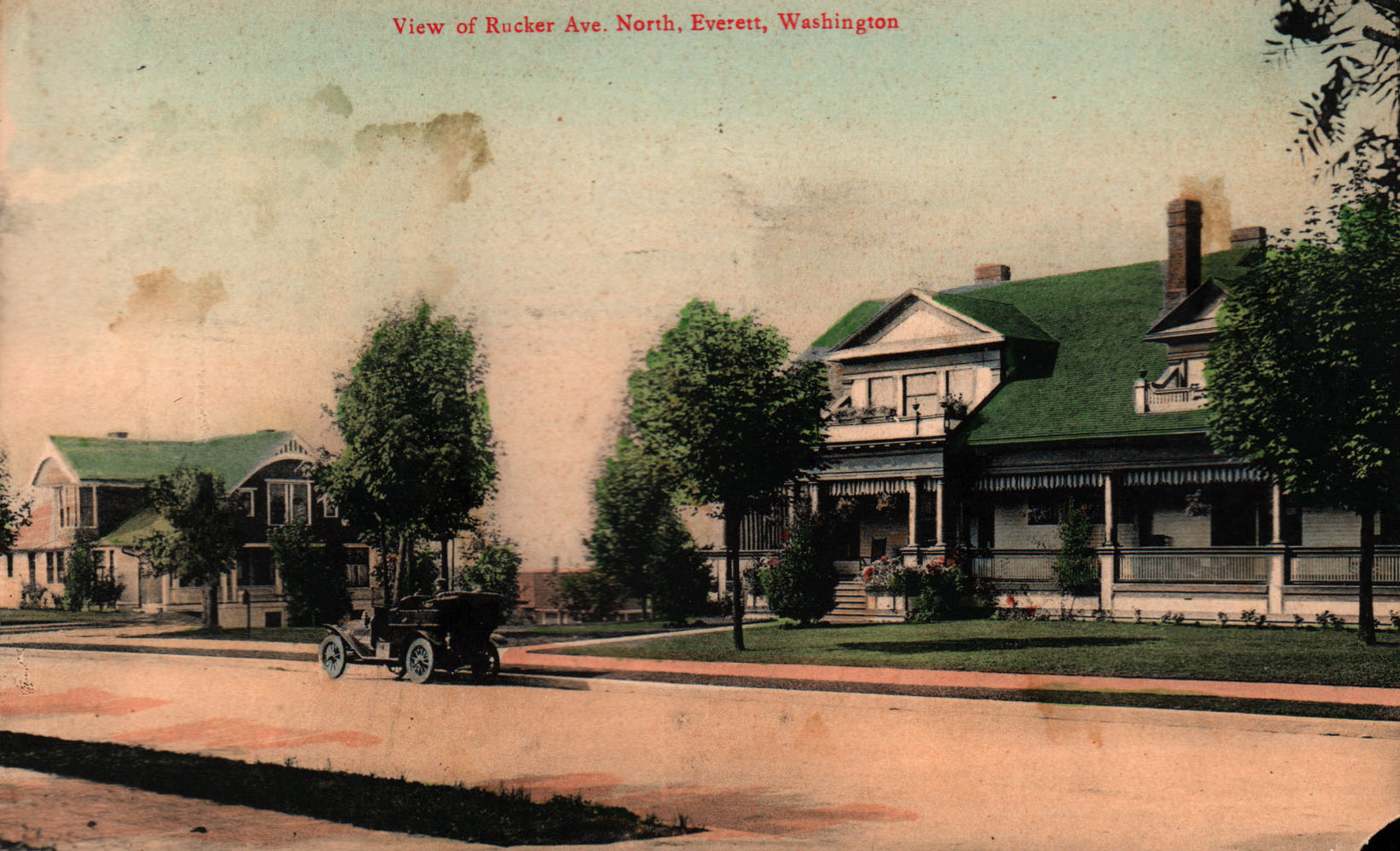 1912 postcard.
Jack O'Donnell collection
1912 postcard.
Jack O'Donnell collection
Governer Roland H and Nina Hartley Mansion (1910)


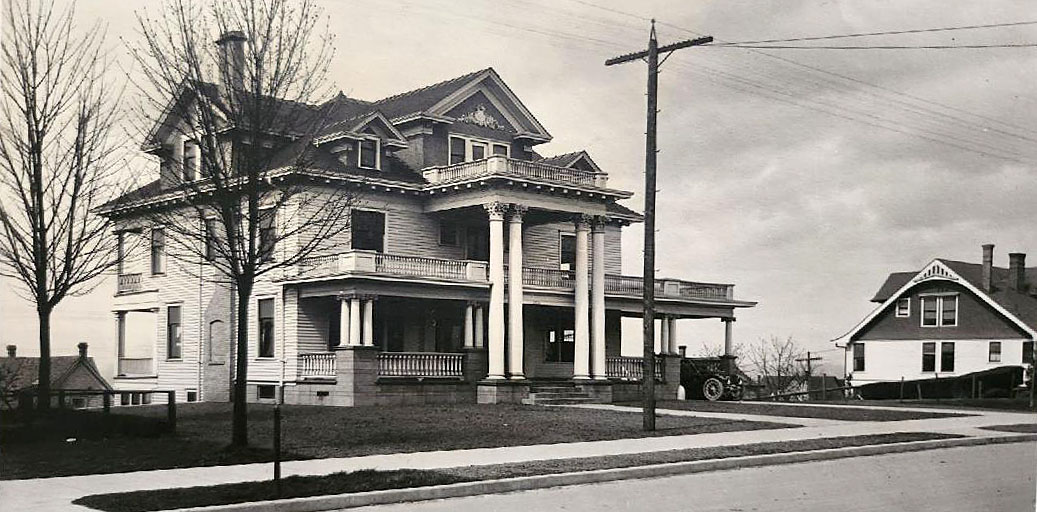
National Register
Governer Roland Hartley
Note: Some sources claim this is a 1911 house.
Roland Hartley immigrated from Canada to Minnestoa, where he worked with mill owner David Clough (who became governor of Minnesota). He married Clough's daughter, Nina Clough. The Clough's lumber mill in Minnesota provided ties for the Great Northern Railroad, who needed a western source as the line expanded west. So the Cloughs moved to Everett in 1900 and started the Clark-Nickerson Mill. The Hartleys followed in 1902. The started the Clough Hartley Cedar Siding and Shake Mill. By 1910, Hartley was mayor of Everett. The Hartleys moved to this house in 1911. He became a state senator and served two terms as Washington governor.
Soundview Nursing Home
There was a remodeling permit issued in 1949 to contractor Ole Sather. Roland Hartley’s oldest son, Edward Hartley, lived at the Hartley Mansion during 1953 and 1954, after Roland died in 1952. The house was vacant for a time, and was for sale in 1957. Lilly Pangborn had an open house for her new Soundview Nursing Home on Sept 7, 1958. Another remodel was announced in December, 1958 for Mrs. Pangborn to change it to a nursing home. More about the house is on Historic Everett.
Everett Neurological Center
Neurosurgeon Dr. Sanford Wright , purchased the house in 1983 for his practice and restored it with the help of his father Sanford Wright Sr.
This elaborate mansion has a ballroom on the third floor where many piano recitals have occured in recent years. The garage has a turnstile to enable the car to be turned around and driven out forward.
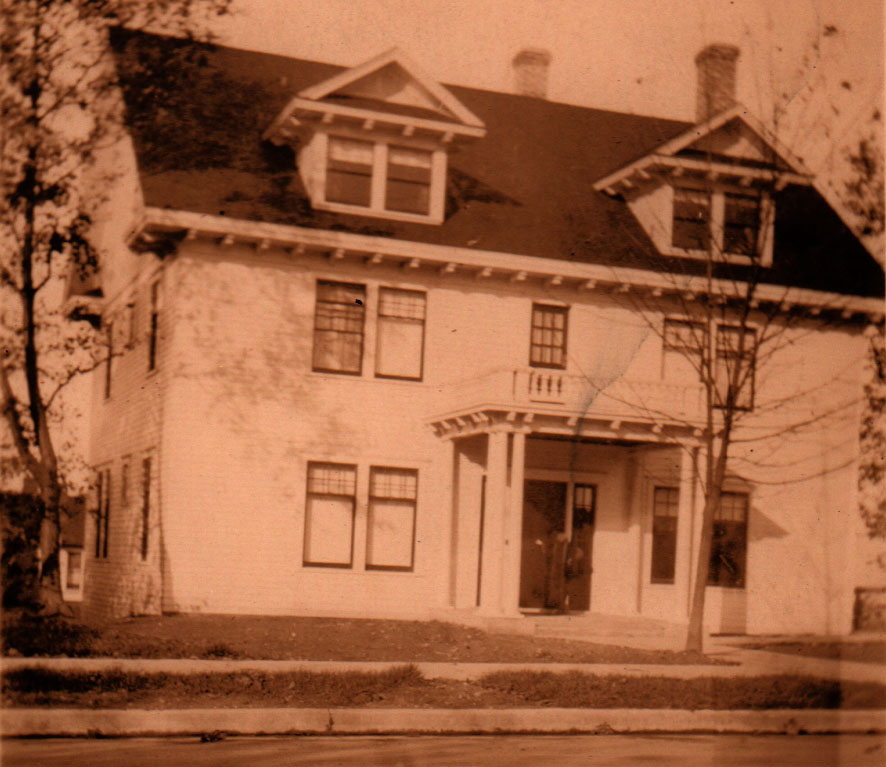
Schumacher Ecklund House (1905)
Curiously, water was turned on for a James G Fairfowl in 1901. However, in 1905 the sewer was hooked up for the Schumachers.
Designed by Benjamin Turnbull.Lewis Frederick Schumacher was a proprieter of the Everett Produce Company. The Schumachers only lived there a few years. After the family retired to Beverly Hills, CA, Arthur Ephriam and Theresa Eckland lived there from 1918 to 1977 -- 59 years. Arthur Eckland was a musician with a piano studio over Costello's, later into the Dorn Building and the Clark Building. In 1920 the house was raided during the prohibition era.
After the Ecklunds left, it was divided up into a boarding home with muliple small apartment rooms upstairs. Gene Fosheim bought it in 1981, and he and his father divided up the awkward single large upstairs bathroom into two, and converted the building into a triplex by adding a kitching in unit #3 in back. The downstairs unit was split into two bedrooms. The Crimson Sentry and Drummondi Norway Maple were planted by the city in 2000. In 2021 he remodeled the downstairs unit again, and replaced the failing concrete bulkhead in the front.
2421-1/2 Rucker
In 1984-85, students from Everett and Cascade High Schools carpetry class built the accessory dwelling unit next to the alley. It was the first computer-generated set of drawings submitted to the city permits department.
Gene Fosheim
Madrona Apartments (1923)
In 1923, the Herald reported this new apartment as "one of the finest structures of its kind... every modern device known in apartment houses, remarkable economy of space and a sense of being finished in every detail and designed for comfort and conveniences mark the design and construction of the building." Vernacular adaptation of Tudor-apartment architectural style. Classical portico with Corinthian columns supporting an ornate balcony with French doors.
Hoyt Ave
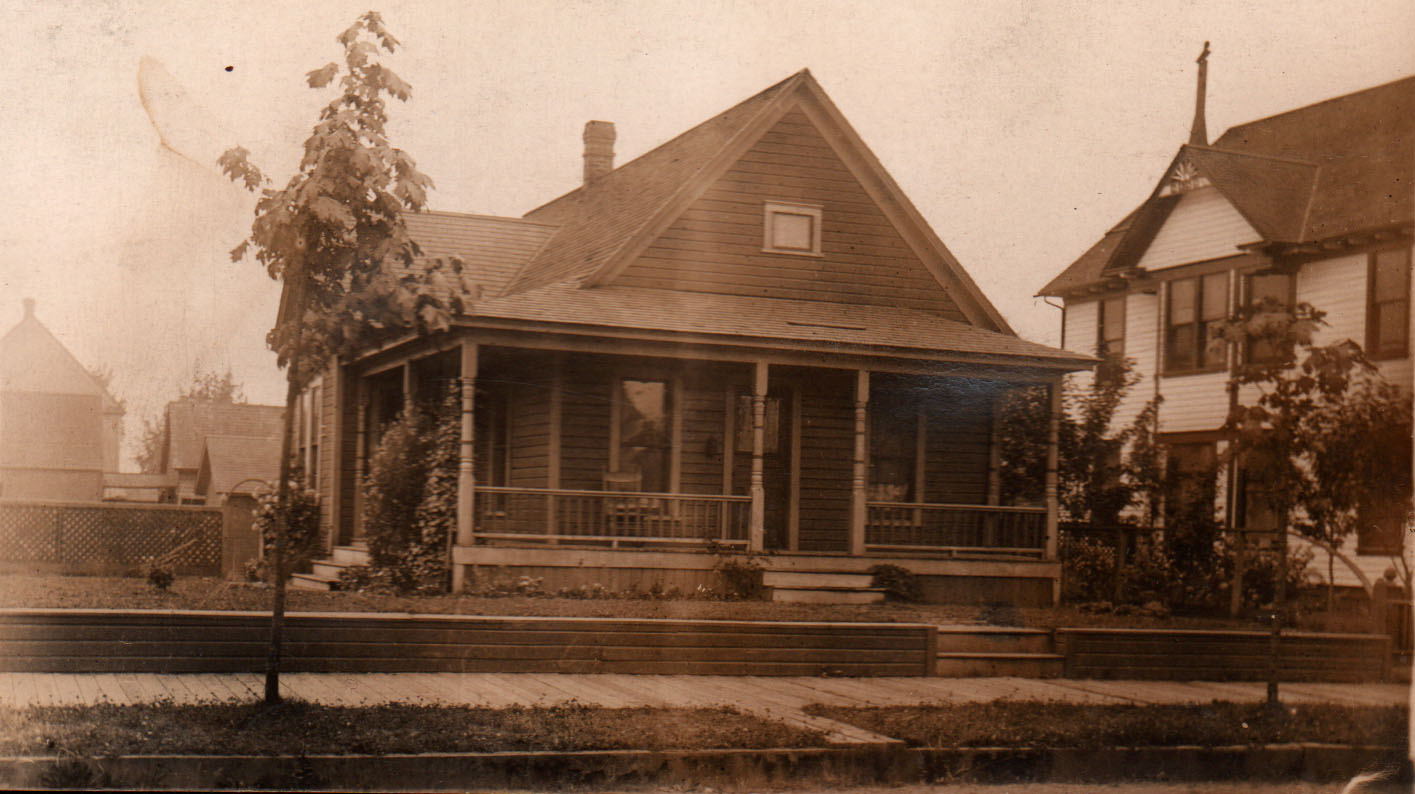
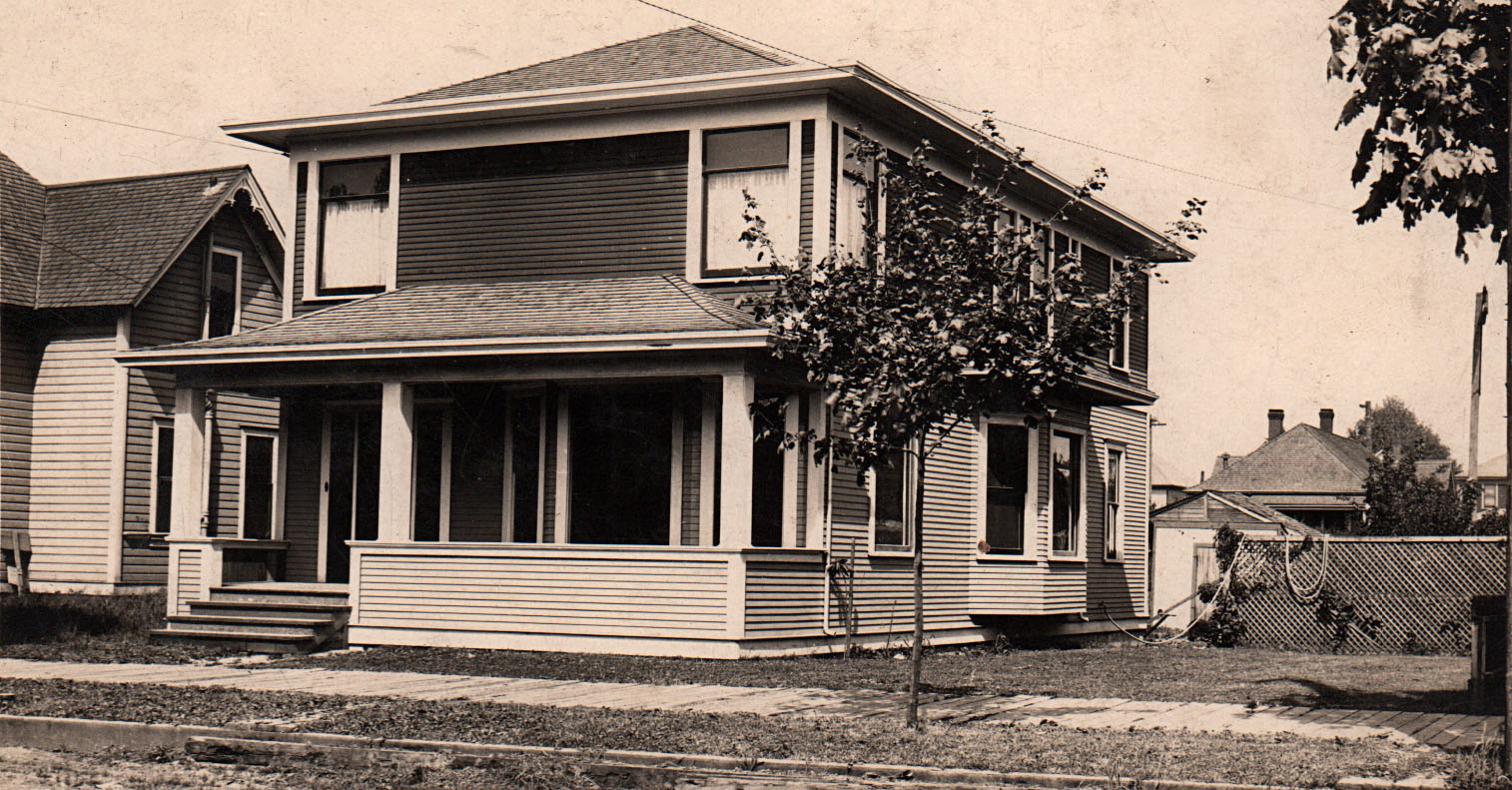 Jack O'Donnell collection
Jack O'Donnell collection
Trinity Episcopal Church (1921)
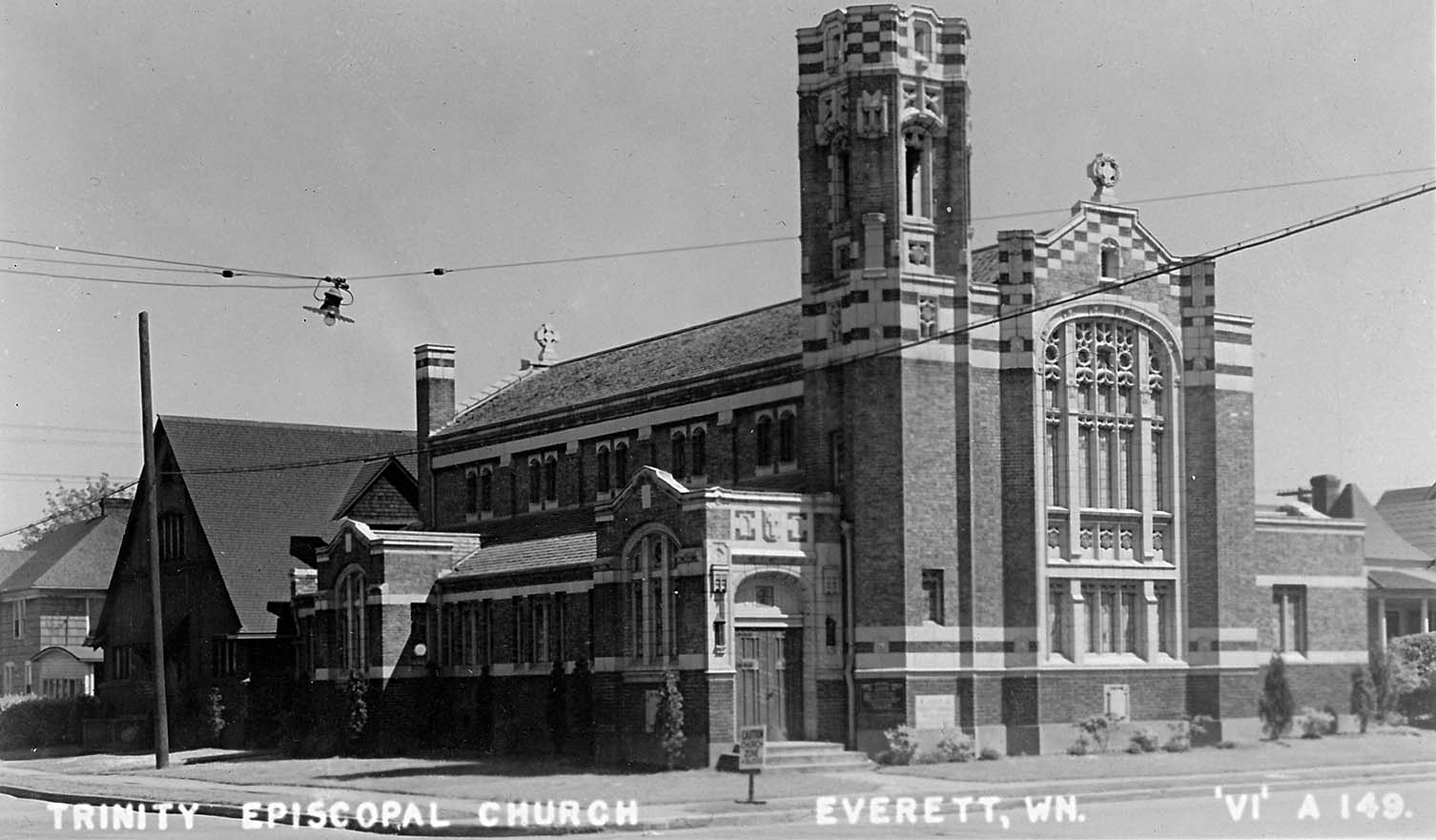
Architect: E.T. Osborne.
This church replaced the smaller 1892 church at California and Wetmore that was built in 1892. This church's cornerstone was laid down just prior to the start of WWI. When the First World War began, work was halted as the working men of Snohomish County and many of its clergy went off to join the war effort. When the war was over, the building was completed in 1921 and dedicated as a WWI Victory Memorial to the brave men and women of Snohomish County (including members of the parish) who had given their lives during the war. It was dedicated on Trinity Sunday in 1921 by Rev. Edgar Martin Rogers. It is a replica of St. Andrew’s Church in Scotland in a tradition of classic church architecture Pastor Rachel Taber-Hamilton research
The stained glass above the altar, on the east wall, is by Charles Connick of Boston. It is said that during transport of the glass to Everett, it was displayed in many cities. Connick's studio produced glass in a traditional Arts and Crafts way, and was one of the most famous in America. His stained glass is in thousands of churches, including St. Patrick's Cathedral in New York and numerous other cathedrals. A contemporary of Tiffany, he prefered the style of medieval stained glass such as Chartres Cathedral, France, where he studied the art.
In 2010, a pipe organ was installed containing some pipes from a 1915 Möller from Spokane, and many pipes from a 1971 organ also in Spokane. It has three manuals, 4 divisions, 41 stops using 1619 pipes.
Rogers Hall, behind the offices just south of the church building, is named for Rev. Edgar Rogers. He arrived in 1911 and was pastor until 1941. It was through his efforts that the church was built. Rogers Hall was completed in 1961, and has a large athletic court on the main floor that's now used for large gatherings. Below is a fallout shelter with meeting rooms, an choir room, and classrooms.
The office just south of the church was built in 1967. About that time, the narthex that connects the office to the church and hall buildings was constructed, using similar architectural features as the 1911 church. Inside the narthex, you can see the south wall of the church.
Our Savior's Lutheran Church (1924)
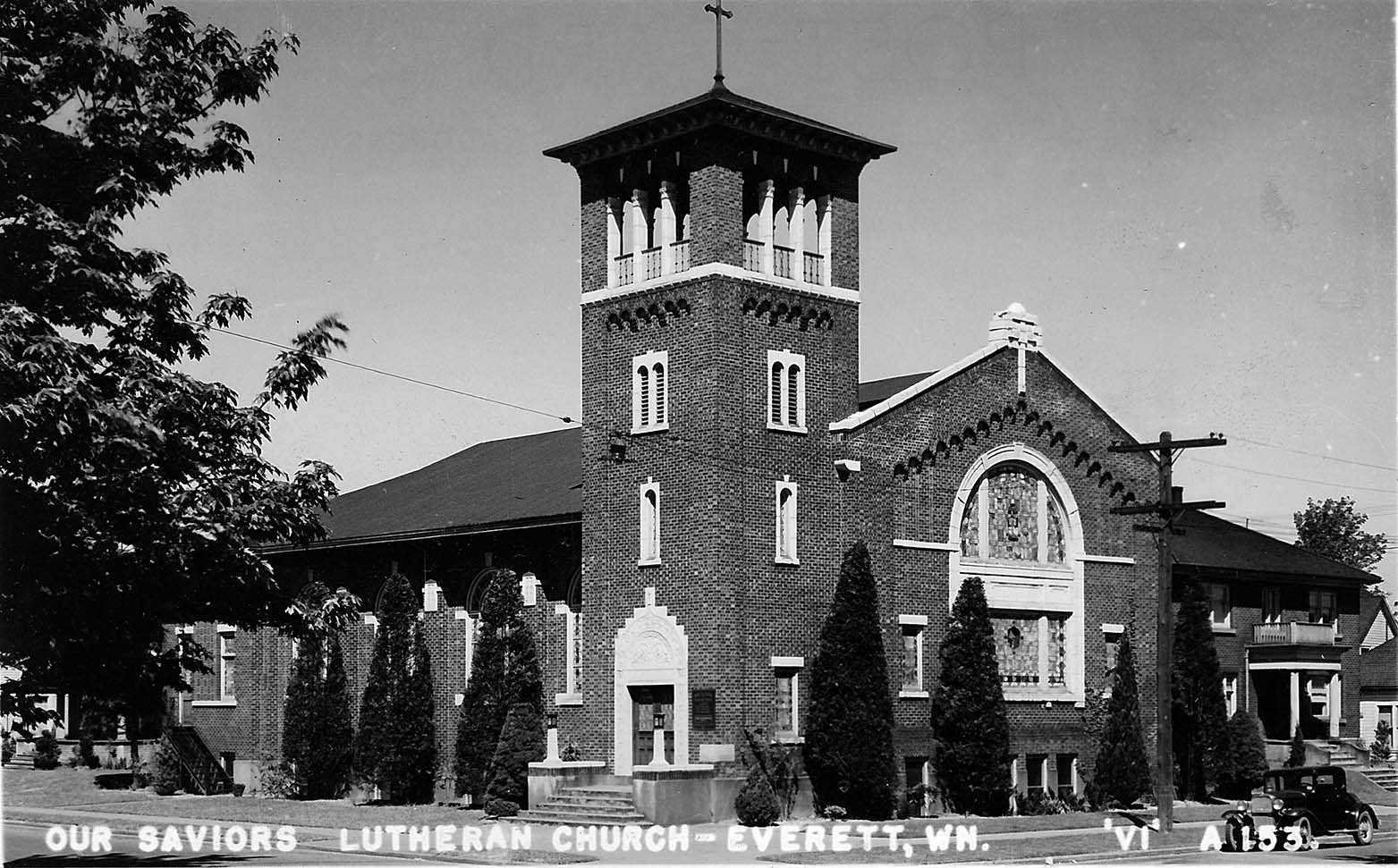
Architect: Andrew Willatsen, a student of Frank Lloyd Wright. Built by Charles Solie for $40,000.
Four lots were purchased by Our Savior's Evangelical Lutheran Church from Mrs. Emma Leonard for $6500, as mentioned in the July 7, 1923 Herald. At the time, Our Savior's had the oldest church building in Everett, on Lombard between Hewitt and Wall (now the location of the Everett Events Center).
Pastor Norgaard was the first pastor in the new church, remaining there for a long time. An Italianate structure, owned by the Everett School District since 1967 and now used for drama productions at Everett High School. OSLC moved to SW Everett, Dogwood and Mukilteo Blvd.
Charles and Cora Spriesterbach house, Dr. Harmon Rhoads house (1905)
Designed by prominent architect Benjamin F. Turnbull, this house has interesting lead glass windows. Charles Spriesterbach was a realtor, born in Minnesota and In the 1930s, it was the home of Dr. Harmon Rhoads Sr. and family. Their son Dr. Harmon Rhoads Jr. went to Antarctica in 1938 with explorer Hubert Wilkins.
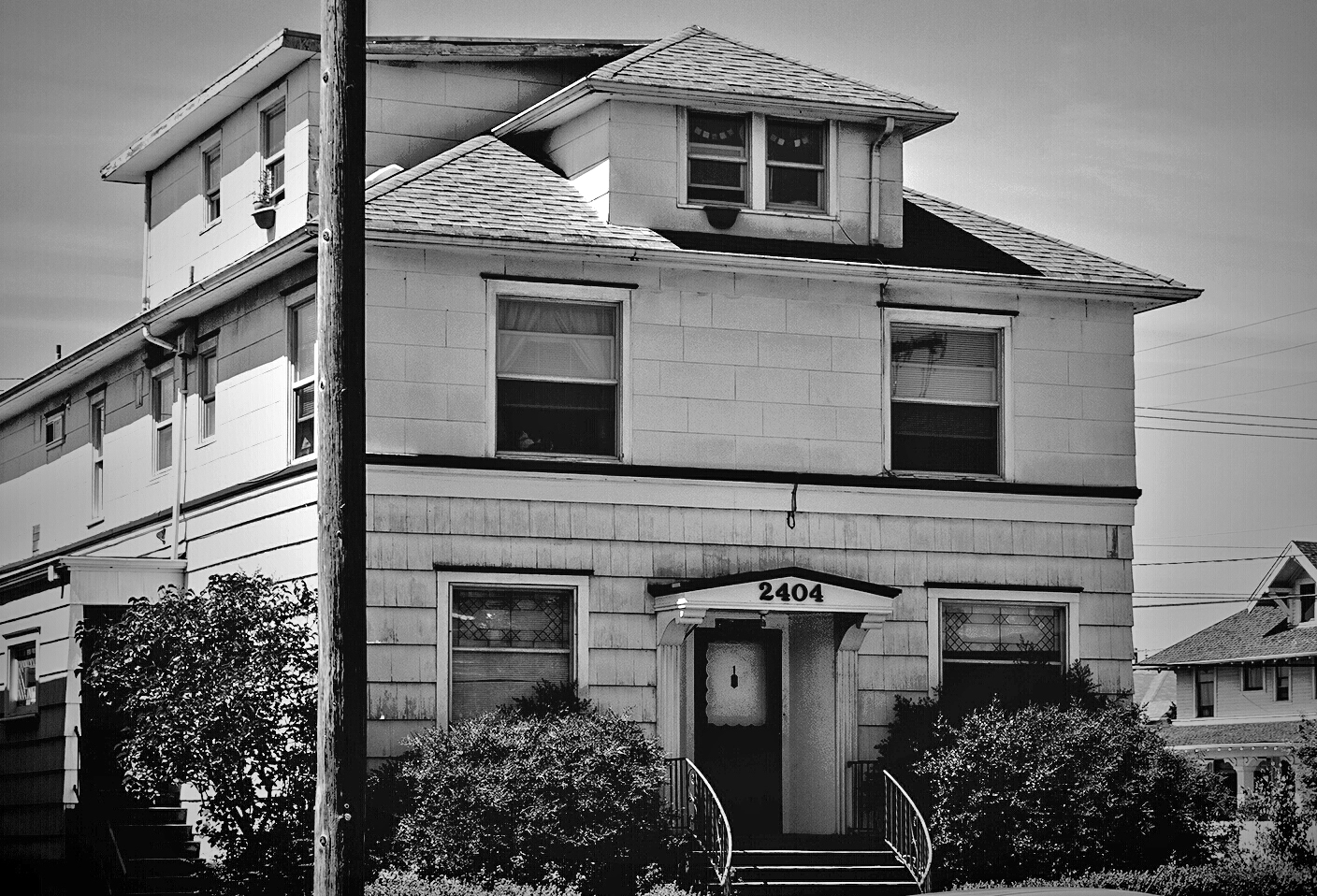 Jack O'Donnell collection
Jack O'Donnell collection
GONE: Immaculate Conception Church (1904-1966)
When Our Lady of Perpetual Help in Riverside outgrew its facilities, this church was built, Reverend H.P. Saindon in charge. (In 1994, the two churches recombined.) The new church was built in 1967. Its interior design was affected by the changes of Vatican II a few years before.
See April 23, 1924 Herald.
Immaculate Conception school (1924)
 Jack O'Donnell collection
Jack O'Donnell collection
Architect: C. Frank Mahon, who also did the Catholic buildings about the same time: Knights of Columbus / Masonic Temple building and Our Lady of Perpetual Help Church. General contractor: Allen D. McAdam.
Father Francis Jones, Immaculate's second pastor, was in charge when this school was built. It replaced several homes that were on the block, including the 2508 address that had a house built in 1911 for N. C. Healy. Estimated at $70,000 or $80,000, it was built during a time when the state law was proposed against parochial schools. Built to accomodate 400 students, originally it was intended to also be a high school. The teaching order of Ursuline Nuns staffed the new school, including Mother Perpetua of St. Ignatius, Montana and seven other nuns.
See Jan 25, Jan 27, Feb 1, Feb 15, Feb 29, 1924 Herald articles.
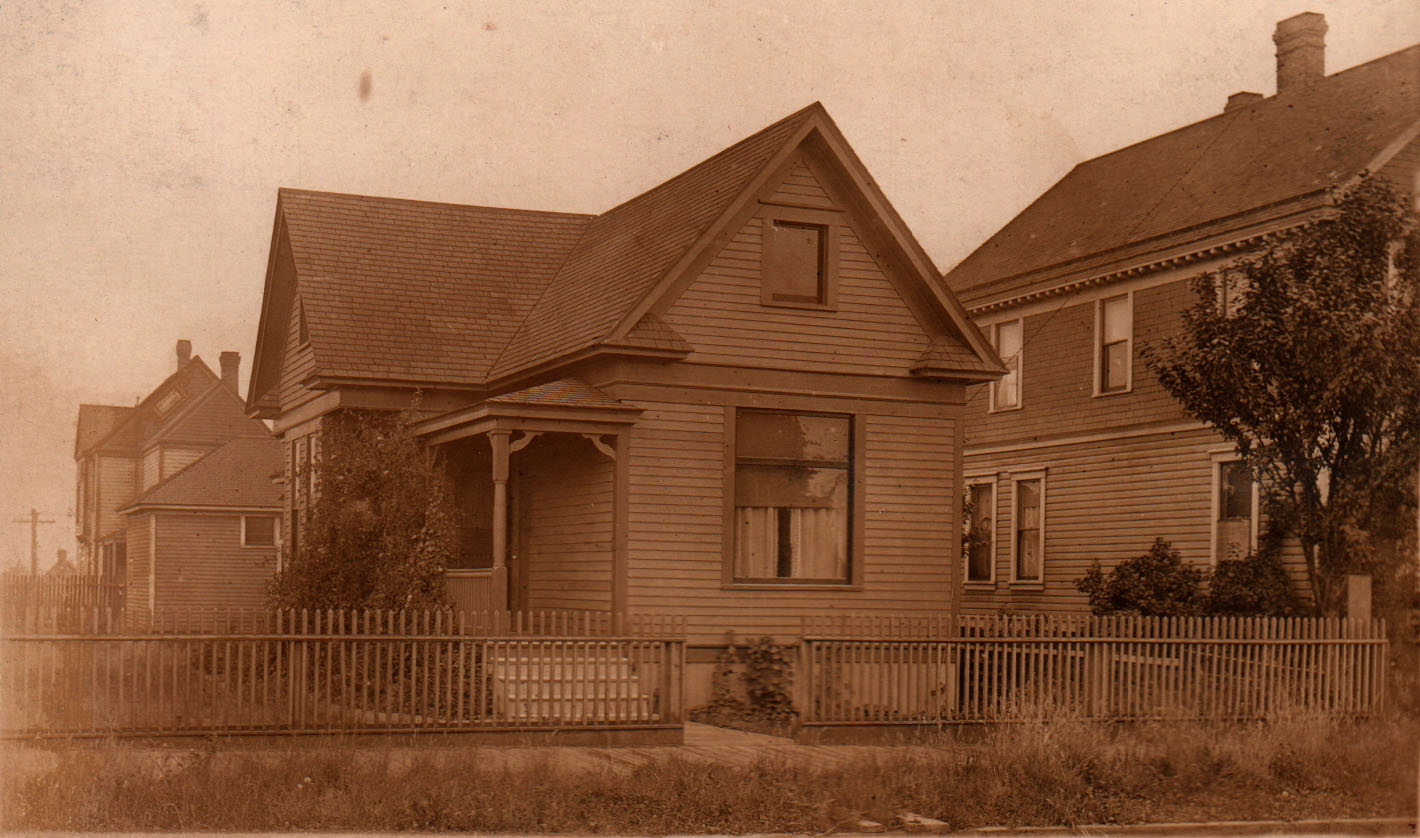 1908.
Jack O'Donnell collection
1908.
Jack O'Donnell collection
First United/Westminster Presbyterian (1929)
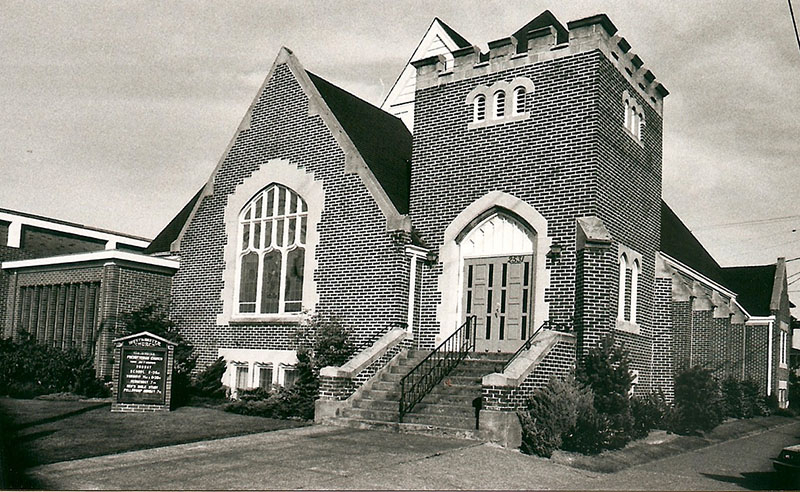 Jack O'Donnell collection
Jack O'Donnell collection
Architect: unknown. Built for $12,000 (including the parsonage).
United Prebyterian started Oct 14, 1900 with missionary pastor L.K. Lanning. In 1901 they decided to build a permanent church at Everett and 2701 Colby, finished in 1902 and remained until the 1928 when Sears bought the site for $40,000. That's the time this church was built
- See Mar 12, 1953 Herald for picture of 2600 block of Hoyt.
Raborn House (1892)
Owned by a prominent contractor, the Queen Anne style house is graced with turrets, circular bays, a complex roofline with steeply pitched gables, a decorative porch and shingle siding.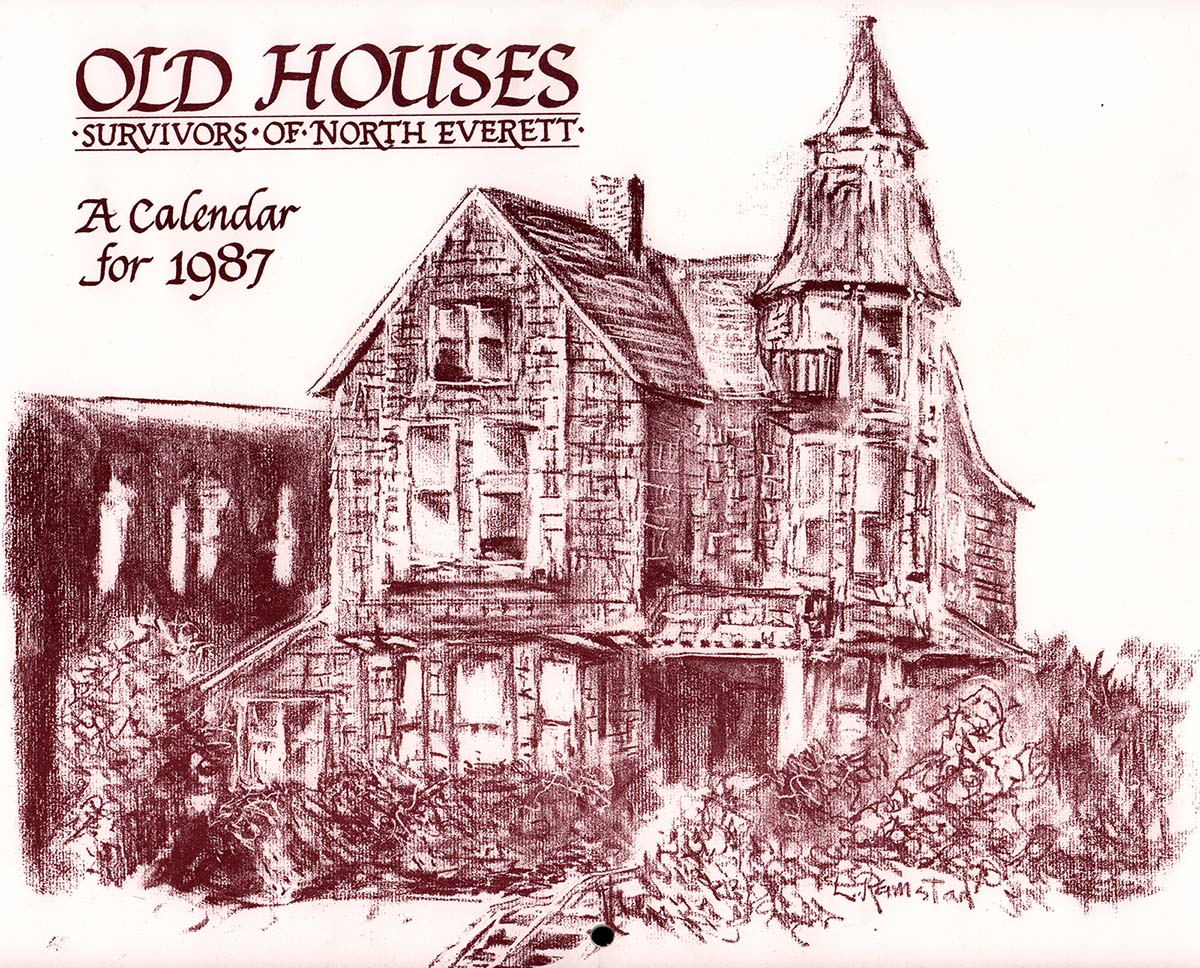
 Mrs. M. J. Bird sent this in 1908.
Jack O'Donnell collection
Mrs. M. J. Bird sent this in 1908.
Jack O'Donnell collection
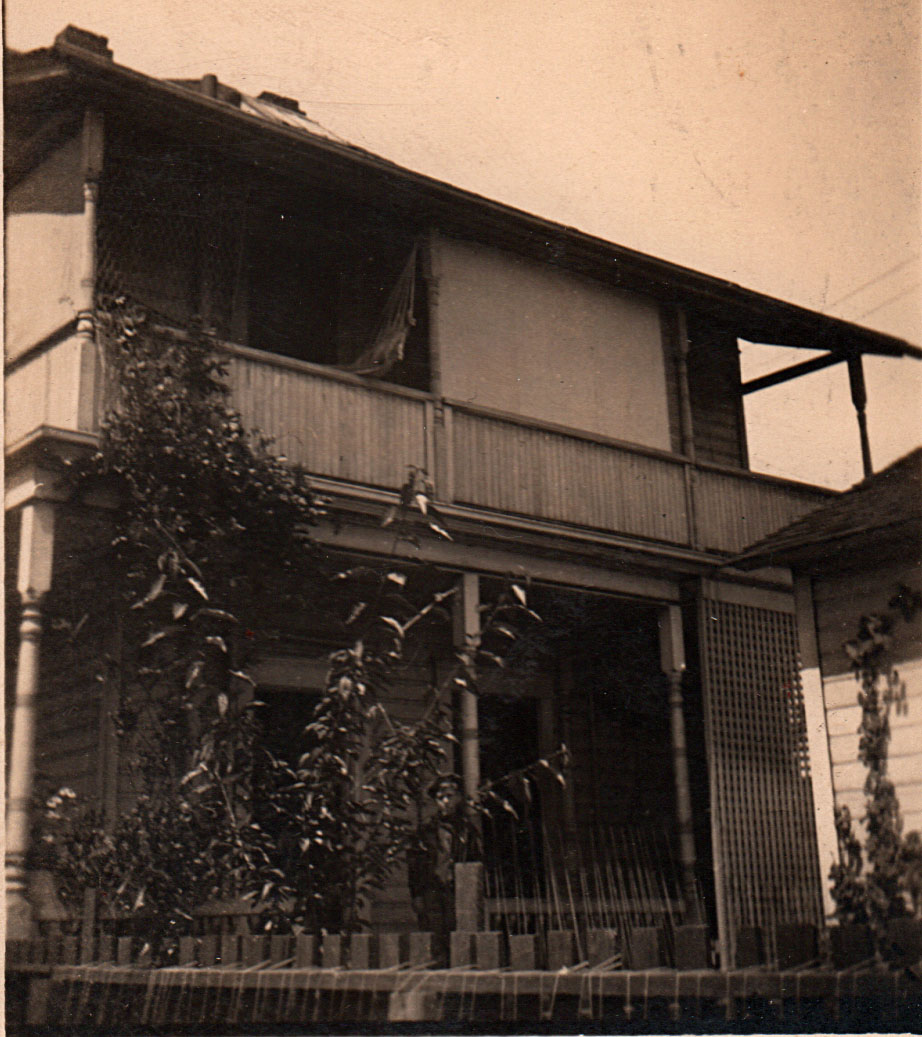 1910.
Jack O'Donnell collection
1910.
Jack O'Donnell collection
First Swedish Baptist/Bethel Baptist Church (1913)
Organized in August 1901 by 14 members who used a tent at the YMCA lot. Rev G.A. Osbrink led the congregation when they built a sanctuary 1902 which held 150 people.
Mayfair Apartments (1929)
Rudolf Hartmann/Windsor Apartments (1923)
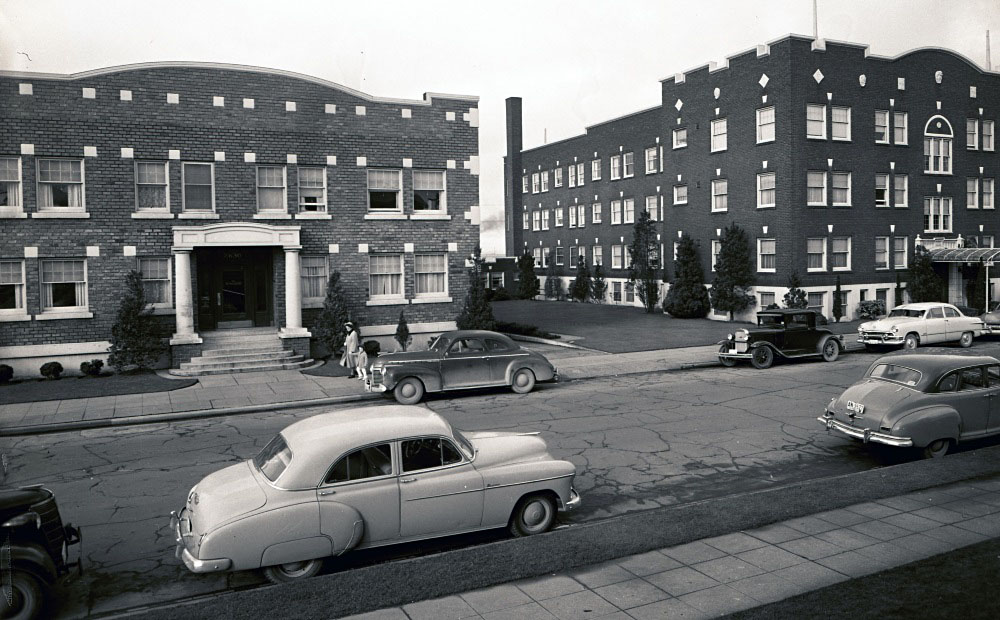
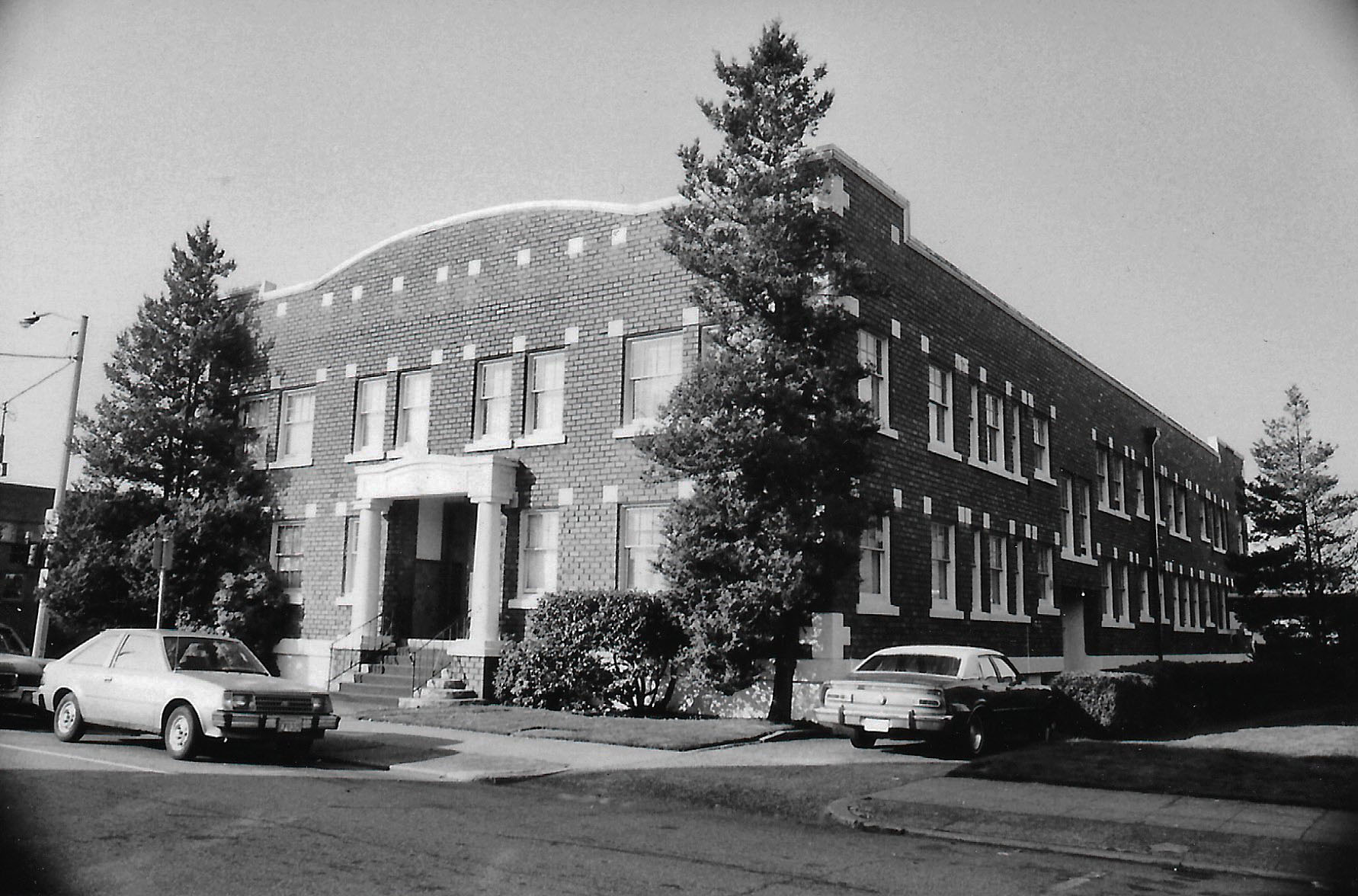
Mayfair
This was addressed as 2620 Hoyt in an ad in the August 11, 1929 Herald, ready for occupancy on September 1. The ad by R. Hartmann said it was one of the finest and up-to-date apartment houses in the Northwest. Norge refrigeration, Hot Point automatic electric ranges, West Wind fans, hardwood floors, built-in tubs and showers! Jasper L. and Gertrude Rucker lived here in 1930-31. Gertrude Cleaver had grown up at 1632 Rucker.
The Sept 1, 1929 Herald stated that the three-story, 35 apartment brick building had the latest in modern conveniences. In the basement were laundry tubs, drying rooms and store rooms. Hardwood waxed flores, tiled bathrooms, modern kitchens and attractive breakfast nooks were in each apartment. Various styles included five-room, four-room, three-room and bachelor apartments.
Hartmann/Windsor
This brick veneer building was announced in the January 3, 1923 Herald, and again on the 18th for the $35,000 building. By the April 7 Herald, the brick veneer work was to start, and interior work the week later. Later it was called the Windsor Apartments (but wasn't the first "Windsor" apartments in Everett). The top floor burned sometime between 1940-43 and was removed.
In the 1926 Polk Directory, Mabel E. McBain lived here, a teacher at High School. She was very active in The Mountaineers. See HistoryLink article.
"Skykomish lookout station on the summit of Cleveland Mountain in the Snoqualmie National Forest is to be manned by a woman this summer. Miss Mabel McBain, a school teacher and a member of the Mountaineers' Club of Everett. Miss McBain will live alone in a tent on top of the mountain, until the standard lookout station is erected there, with her telephone, her fire finder and other lookout equipment." The Portsmouth Herald - New Hampshire, July 15, 1918
Colby Ave

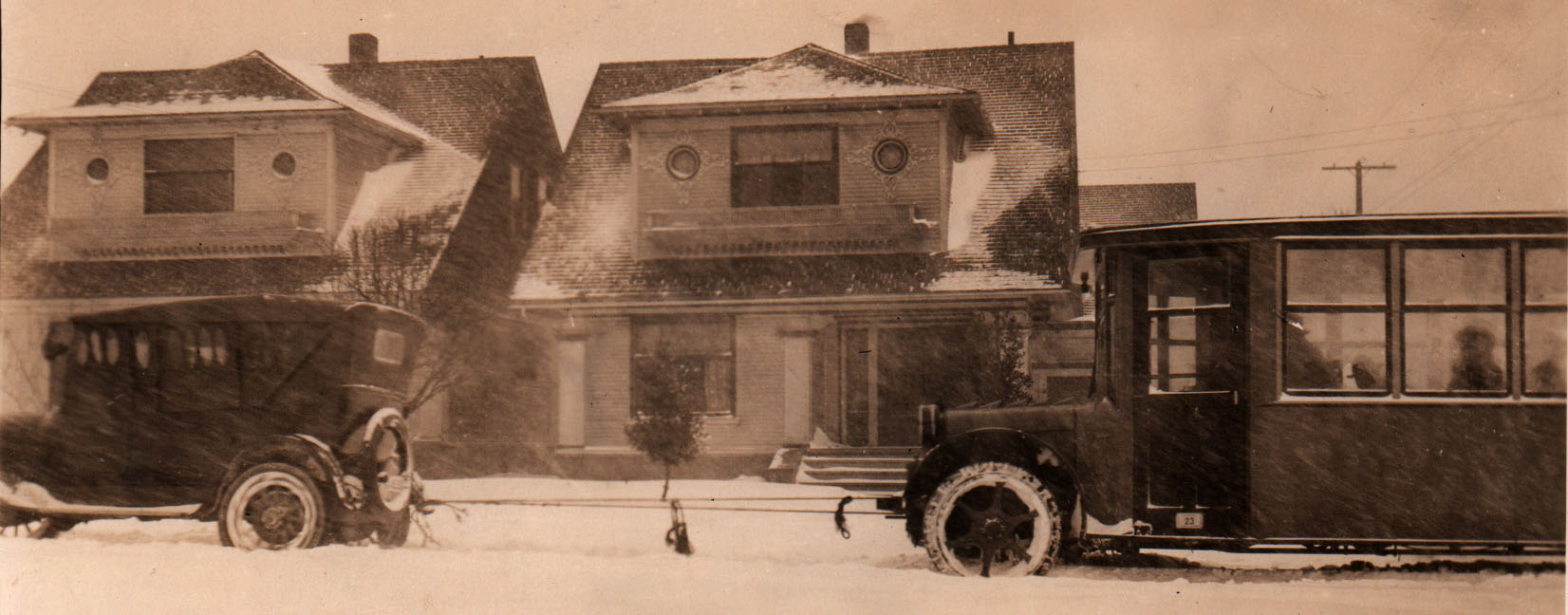 A Fageol Safety Coach being towed in front of the house after some snow.
Feb 15, 1923.
Everett was proud to be one of the first cities to switch from trolleys to buses.
Looks like this bus didn't negotiate snow as well.
Jack O'Donnell collection
A Fageol Safety Coach being towed in front of the house after some snow.
Feb 15, 1923.
Everett was proud to be one of the first cities to switch from trolleys to buses.
Looks like this bus didn't negotiate snow as well.
Jack O'Donnell collection
Van Valey House (1914)
Everett Register
A fine example of American Foursquare design, inspired by the Prairie Style made popular by Frank Lloyd Wright. A.L. Van Valey owned a bottling company in Everett, which bottled 7UP and Rainier beer amongst other beverages. Built for $5000. The Van Valeys hosted recitals, readings and civic group meetings.
Van Valey's company went out of business. Later it was a restaurant and Red Cross offices. It became a day care and elderly care facility. Ed and Betty Morrow purchased it in 1979, and donated it to the city of Everett in 2002. In 2022, the city transfered it to the Everett Museum of History.
See more about the Van Valey house from Historic Everett.
Werner's Market
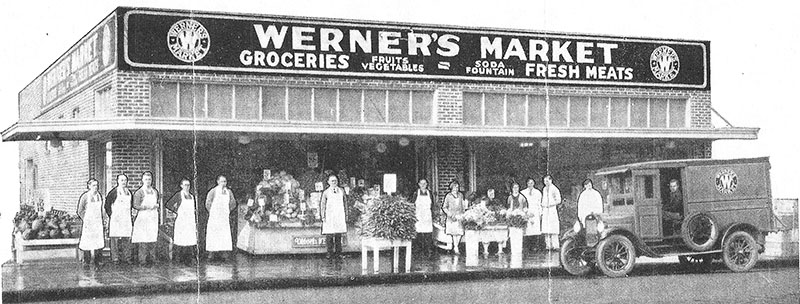
John A. and Flora B. Zoble house (1908)
Everett Register property in 1998.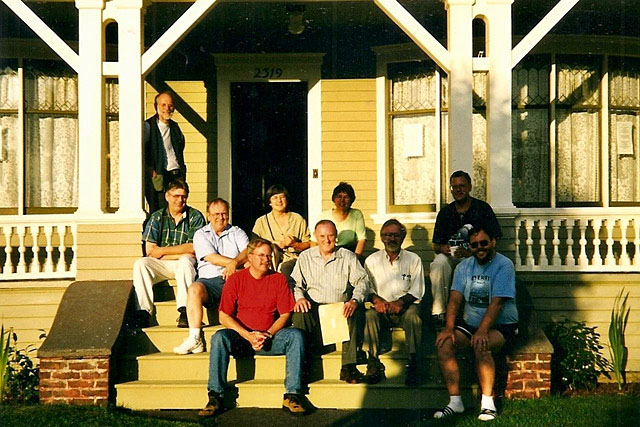
John Zoble was the head miller at the Everett Flour Mill Co. He and Flora were born in New York state. It appears they both died with days of each other in 1934, Richmond Beach WA.
In 1909, Max Elster, teacher of violin had a studio there. Also the Sahlingers lived there about that time and were there through some of the 1920s.
Everett Civic Auditorium
Everett High School (1910)
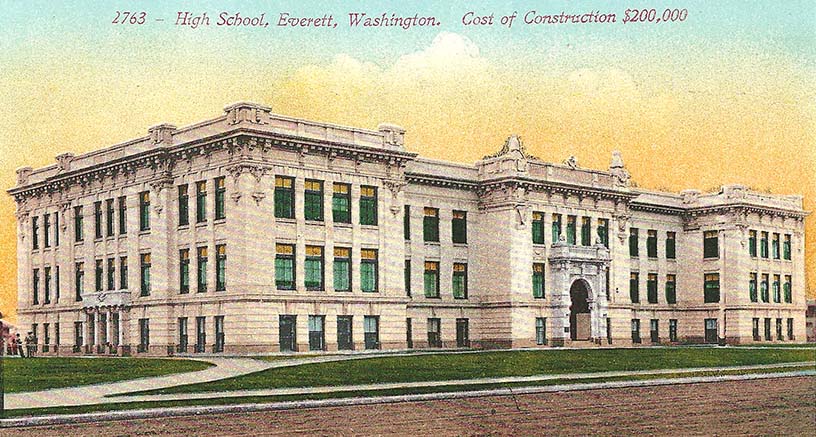
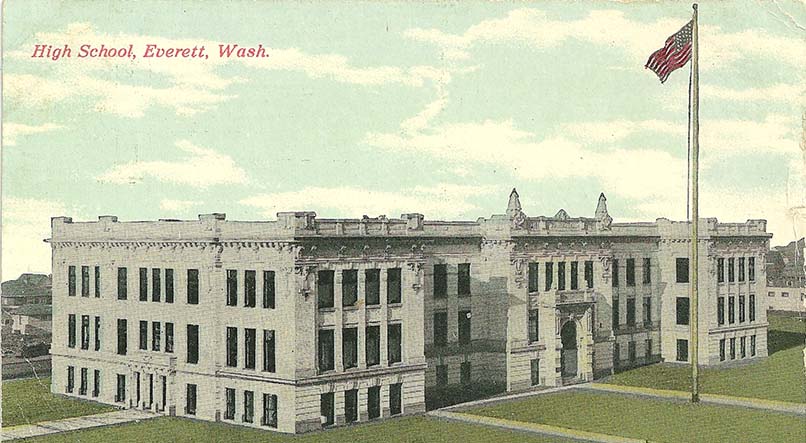
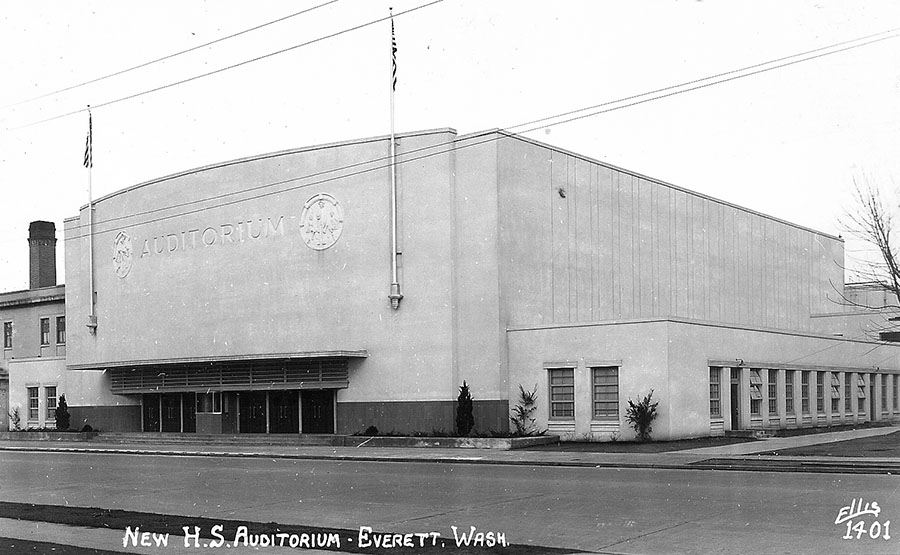
Architect: James Stephen. Built by Jenkins and Jones for $200,000.Ol
The pride of the Everett School District was the new Everett High School which opened Jan 31, 1910. The trhee-story Beaux Arts brick structure cost nearly $200,000 and could house 600 students. Constructed on an entire city block, it was designed by James Stephen who had also designed Washington School. Jenkins and Jones were the primary contractors. Note the white brick, and terra cotta entrance arches, window trim, and cornices. The historic entry was retained with wide corridors, generous stairs and a series of focal public space. The building is surrounded by an open lawn, arch sidewalks and formal tree plantings that reinforce the formality of the architecture.
The building came at the end of a decade of growth that saw Everett's population triple. It was followed by the Vocational and Commercial buildings across the street, 1912 and 1915 respectively. Both were designed by Everett's Benjamin Turnbull. In 1940 the Civic Auditorium, designed by Earl Morrison, replaced the old Lincoln School.
Bell Court Apartments (1909)
This was the first apartment building in Everett. It was built by James Elizah Bell, president of the Lumberman's Association. Bell travelled throughout the Orient arranging business connections and shipping facilities. He also ran lumber and mill companies. He started the Model Stables Transfer and Storage Company in the livery stables on Grand Avenue, now the Public Market.
Wetmore Ave
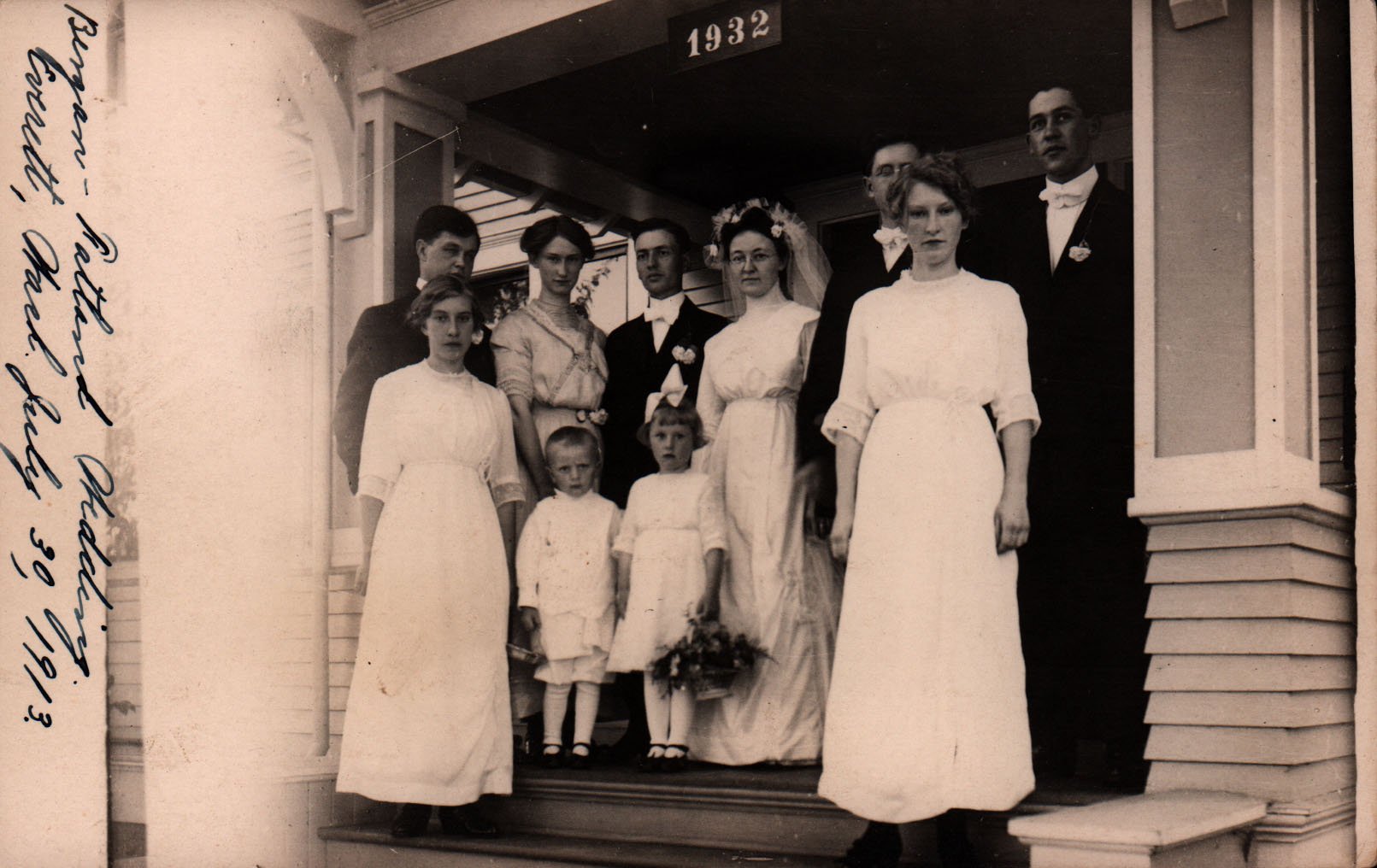 Bergen-Farland? wedding, July 30, 1913.
Jack O'Donnell collection
Bergen-Farland? wedding, July 30, 1913.
Jack O'Donnell collection
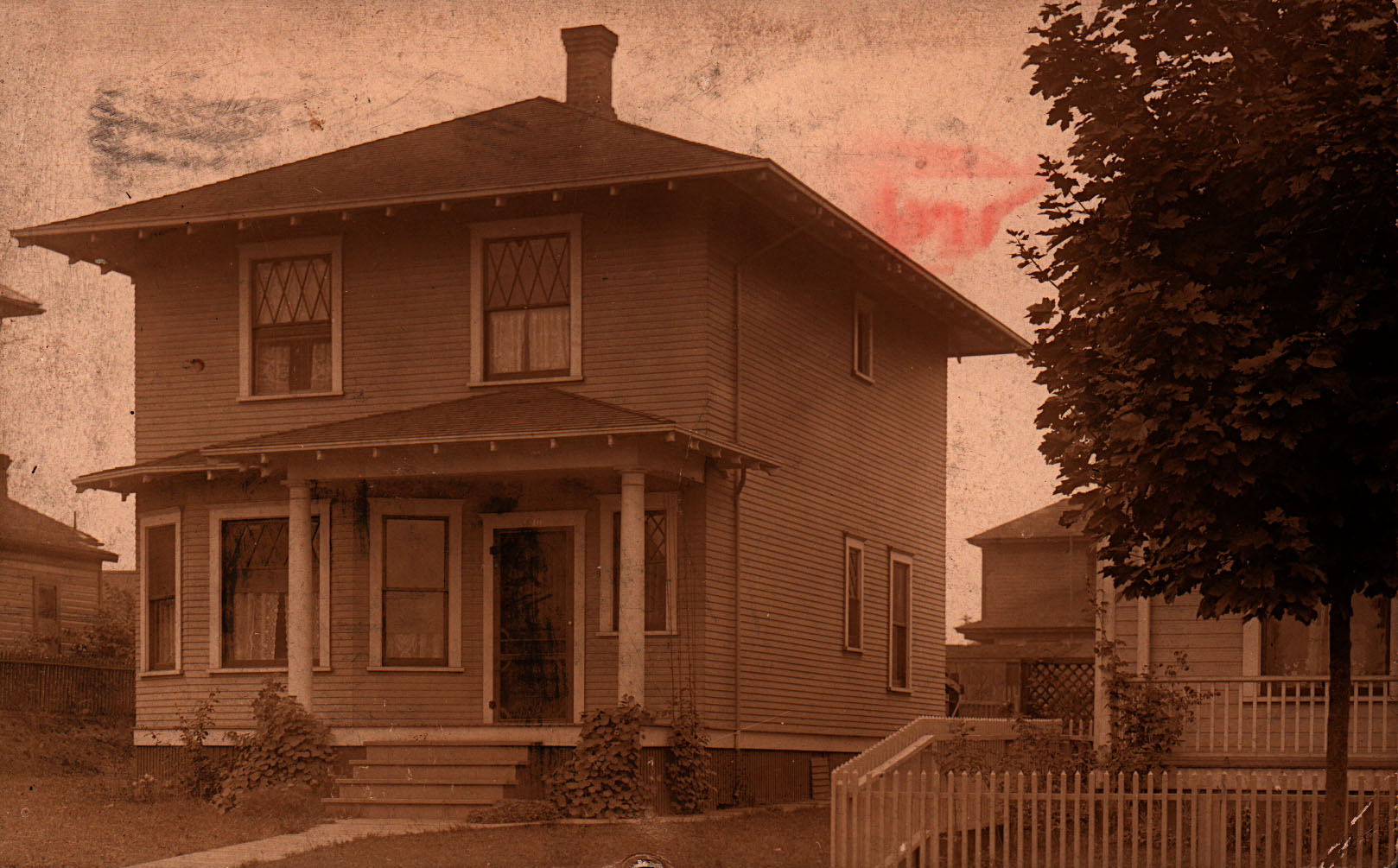 A postcard mailed from James and Lillian Cain to Mary Cain in New Brunswick, Sept 4, 1907.
Jack O'Donnell collection
A postcard mailed from James and Lillian Cain to Mary Cain in New Brunswick, Sept 4, 1907.
Jack O'Donnell collection
Jennie and John Samuels house
Jennie and John Samuels and their son Wesley, lived here from about 1900 to early 1950’s. Son J. Wesley Samuels graduated from Everett High School in 1912. The Samuels were an African-American family. For many years, the Samuels house was listed in a travel publication known as the Green Book, a travel guide for African- Americans. The Samuels residence was listed as a tourist home for black motorists where black travelers could find accommodations. See Herald article.
John Samuels is listed in Polk Directories as a cook in 1901, and a porter for the Great Northern Railway in 1902. In 1907 he is listed as a janitor in the Wisconsin Building. He died in 1952.
Jennie was active in forming the Washington State Chapter of the National Association of Colored Women’s Clubs during the 1920’s. She died in 1948.
Their son J. Wesley (1891-1954) was a WWI veteran who served overseas in France. The 1912 Everett High School Nesika stated that "W stands for Wesley, with voice low and deep, if he sang a sad song, he could make one weep.". Wesley began work as a clerk at Bayside Ironworks after high school. In 1920 he was a bookkeeper for Bayside Ironworks. By 1925 he was accountant with American Boiler Works of Everett. By 1933, he advanced to the position of Company Secretary for American Boiler Works in Everett.
More about Wesley Samuels by Neil Anderson.
Wesley’s grandfather, Alford Samuels, was a civil war veteran serving with Union forces and buried at Evergreen Cemetery. He died in 1903.Rockefeller Ave
Calvary Lutheran Church (1902)
Here is one of the early Everett wooden churches. The Zion Norwegian Evangelical Lutheran Church started meeting in 1900 at the YMCA. They erected this in 1902. In the early 1940s they changed the name to Calvary Lutheran Church. 1915 photo at EPL.
First Congregational Church
 The new church in Jan 6, 1959.
Sno-Isle Library collection of Everett Herald Jim Leo photos
The new church in Jan 6, 1959.
Sno-Isle Library collection of Everett Herald Jim Leo photos
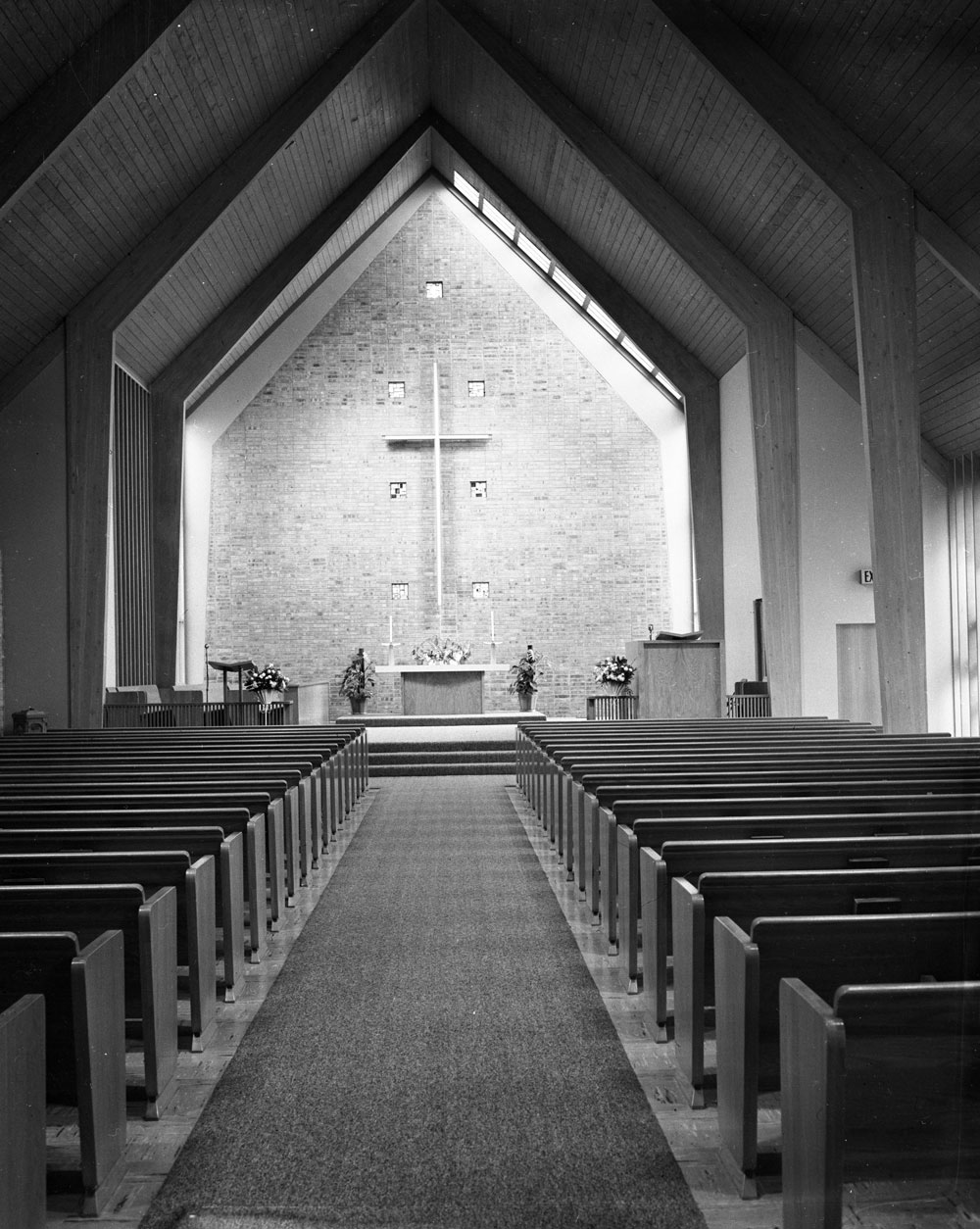 New church interior, Jan 6, 1959.
Sno-Isle Library collection of Everett Herald Jim Leo photos
New church interior, Jan 6, 1959.
Sno-Isle Library collection of Everett Herald Jim Leo photos
In 1893, layman J.U. Judd headed up a group to start this congregation at a school room at 2915 Maple. Rev. T.W. Butler started that first year. They built a modest church south of Hewitt on Cedar St. in 1895, in use until 1906 when the second was built.
Fund driving for a new church was launched in 1964. Additions in 1968 by architect Harry E. Botesch. The third church dates from mid-century.
Central Lutheran Church (1926)
Architect: Benjamin Turnbull.
This congregation was organized in late 1904 as Ebenezer United Norwegian Evangelical Lutheran Church. When they began meeting in a store at California and Broadway, all preaching, singing and Sunday school was in Norwegian. There was a wood framed church at this corner about 1906. In 1913, they changed their services to English. By 1919 the name was changed to Ebenezer English Lutheran Church. This sanctuary was dedicated Oct 17, 1926 and renamed Central Lutheran Church. The original wood framed church was moved to the NE corner of 25th and Lombard -- it's still there.
Oakes Ave
Bethany Temple (1925)
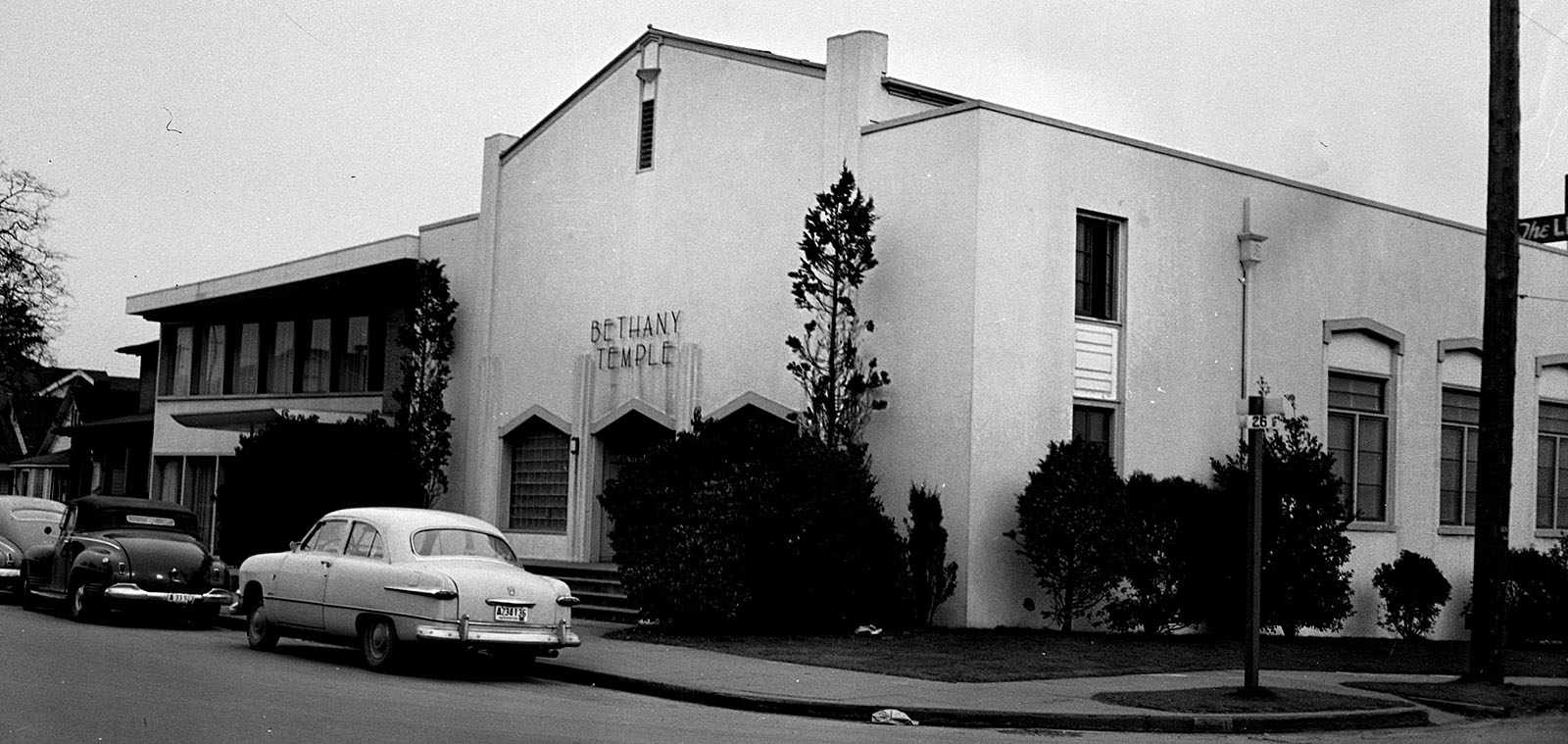
Originally, there was a house built before 1903 at this address. The Apr 25, 1925 Herald has an announcment for Bethany Temple to be built, led by Rev. E. O. Robeck from Bakersfield CA. The dedication was on June 28, 1925.
()
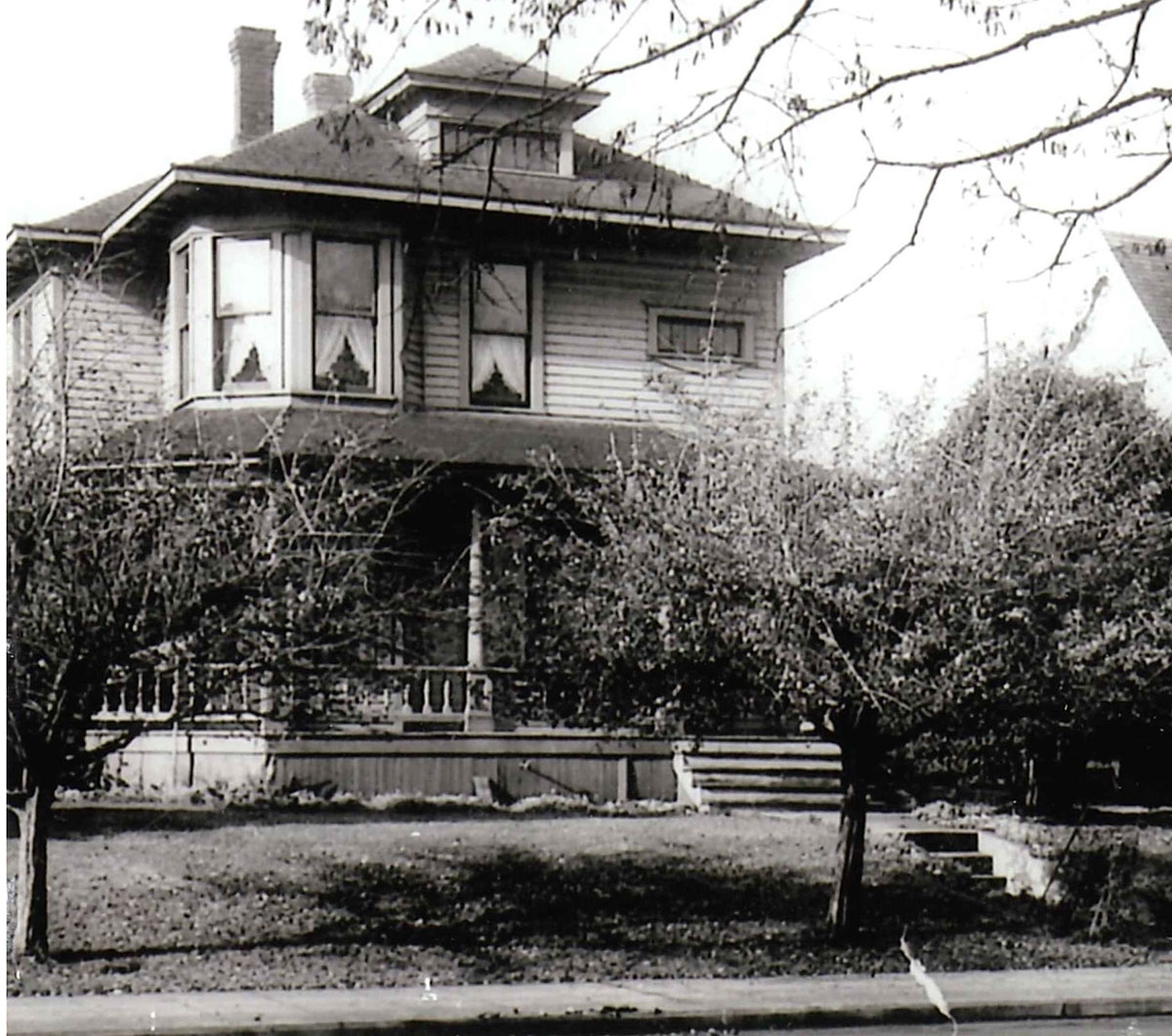 Jack O'Donnell collection
Jack O'Donnell collection
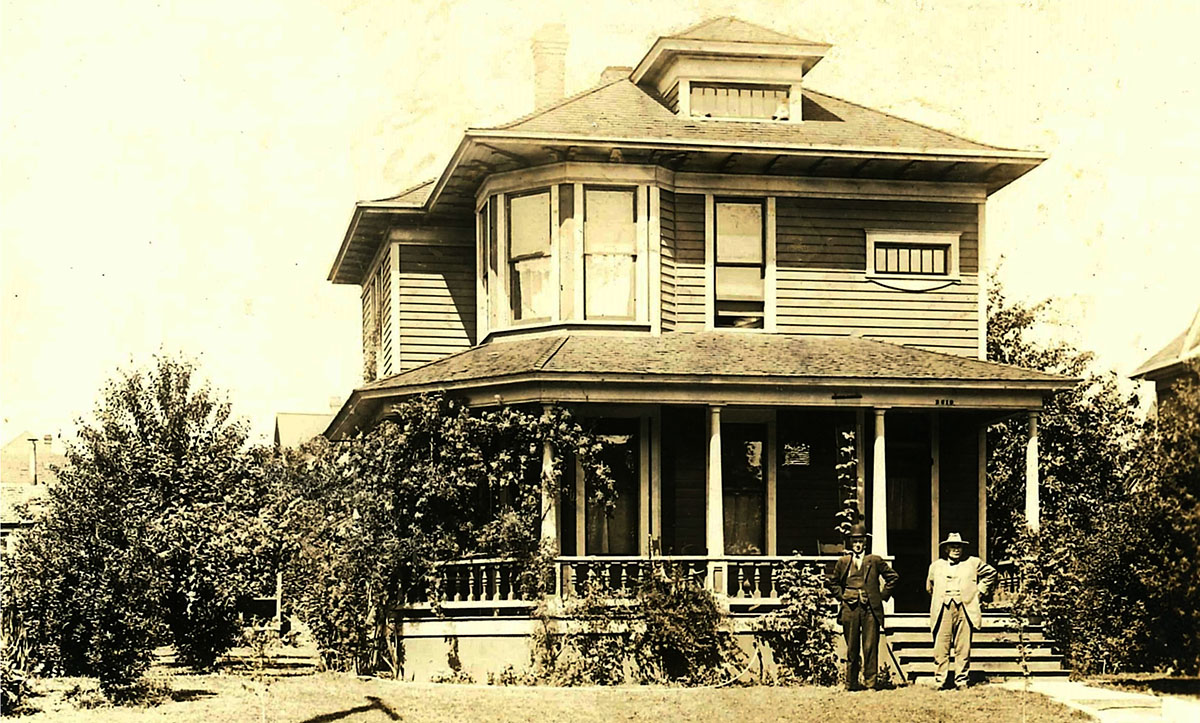 Man on the right is Joshua C Taylor, great grandfather of Becky Wilson.
Becky Wilson collection
Man on the right is Joshua C Taylor, great grandfather of Becky Wilson.
Becky Wilson collection
Lombard Ave
John and Augusta Holland house (1924)
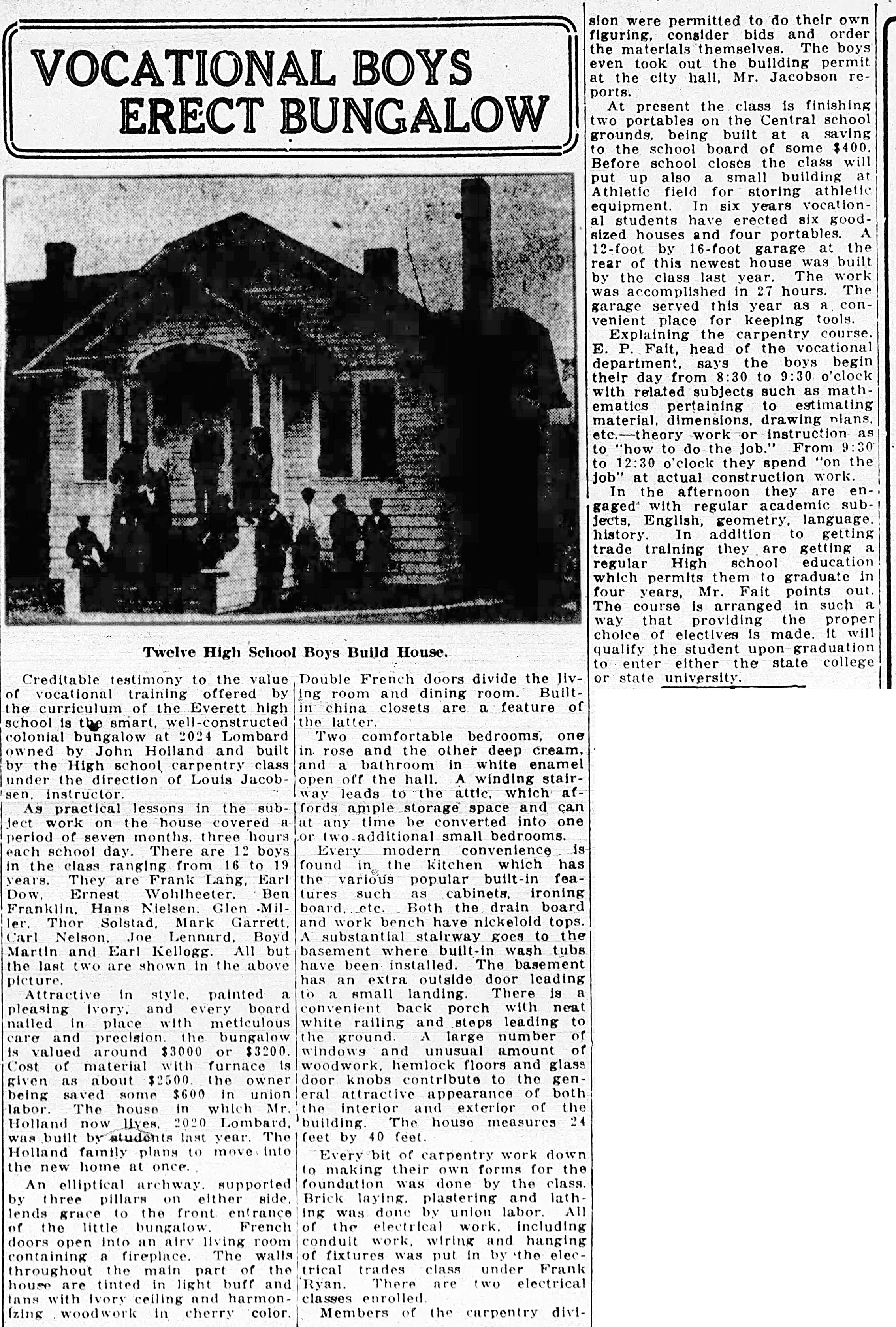
This house was build by Everett High School students, as part of their vocational training curriculum. The carpentry class worked on it for seven months, three hours each school day. It was valued at $3000-$3200 at that time, with the cost for materials about $2500. John Holland was a bookkeeper at Union Transfer Co.
L. J. Loria house (1906 or 1908)
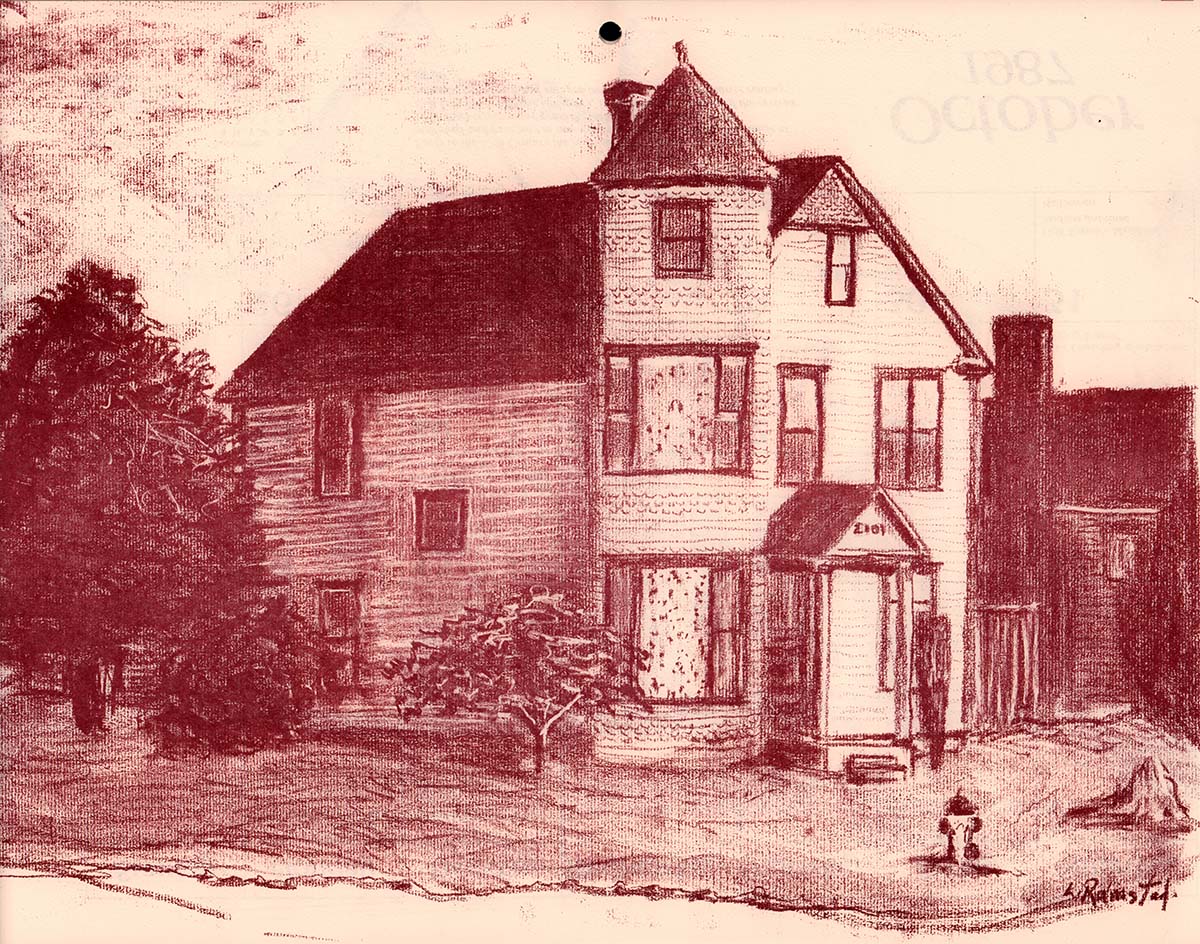
Trinity Lutheran Church (1922)
Architect: Bebb and Gould (Seattle). Built for $15,000.
Bellingham's Rev. T.A. Schoenberg organized this congregation in 1904. Before that, all Lutherans in Everett worshipped in either German, Swedish or Norwegian. In 1927, this was the first church to broadcast radio services in Everett. In June 1929, a grand Moller pipe organ was installed for $3500. The three floor western wing was added in 1955.
Clark Park (1894)

This park was named in 1931 for John Clark, a popular city founder, who had died in 1922.
Starting in 1893, there was a depression nearly as bad as the Great Depression. But Everett voters had the foresight to create this park in July of 1894. The land cost the city $21,345. Thus the first park in Everett, called City Park, was spawned.
The park had few facilities or improvements during the early years. In 1921, the bandstand designed by architect Benjamin F. Turnbull was designed. Everett residents enjoyed band concerts from 1920 (before the grandstand was built) through the 1960s.
In 1927, tennis courts were built, and lighted in 1935. By 1938 there were four tennis courts, two volleyball courts, a softball diamond, and checkers court. In 1946, Clark Park was designated as the only city park where political and religious gatherings were allowed. In 1954 the tennis courts were resurfaced for dancing and roller skating. By 1979, concerts had waned, and the bandstand was demolished. In 1981, the western half of the park was transfered to the School District, where six tennis courts were built. A civil war cannon that was in the park is now stored in a building in Legion Park.
Immanual Lutheran Church (1949)
Architect: William A. Johnson (1862-1943). Built for $11,000.
A church for Everett Lutherans of German descent, this church organized in 1901 under Rev. H.C. Eberling from Snohomish. They first met at the Norwegian Lutheran Church at 2928 Lombard Ave. In 1904, they built a frame strcutre at the NE corner of 26th and Lombard costing $2600. Originally it was called the First German Evangelical Lutheran Church.
Hours after the attack on Pearl Harbor, Dec 7, 1941, the congregation voted to stop worshipping in German.
This church, at the same site, was dedicated July 24, 1949.
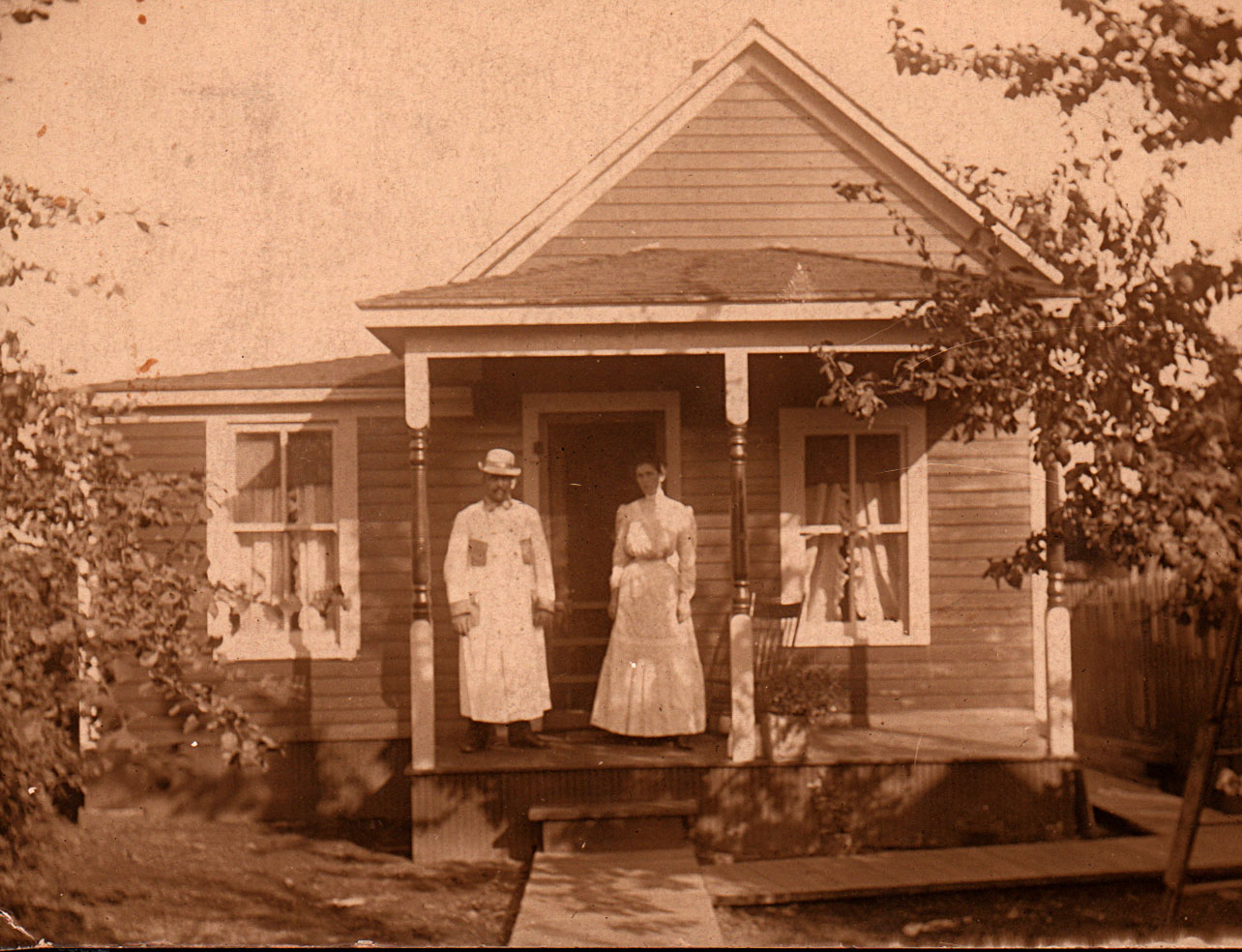
Clyde's Richfield Service Station (GONE)
This service station was where McDonalds is now.
Broadway
Broadway, like Wall St, was probably named after New York City streets by the Rockefeller syndicate.
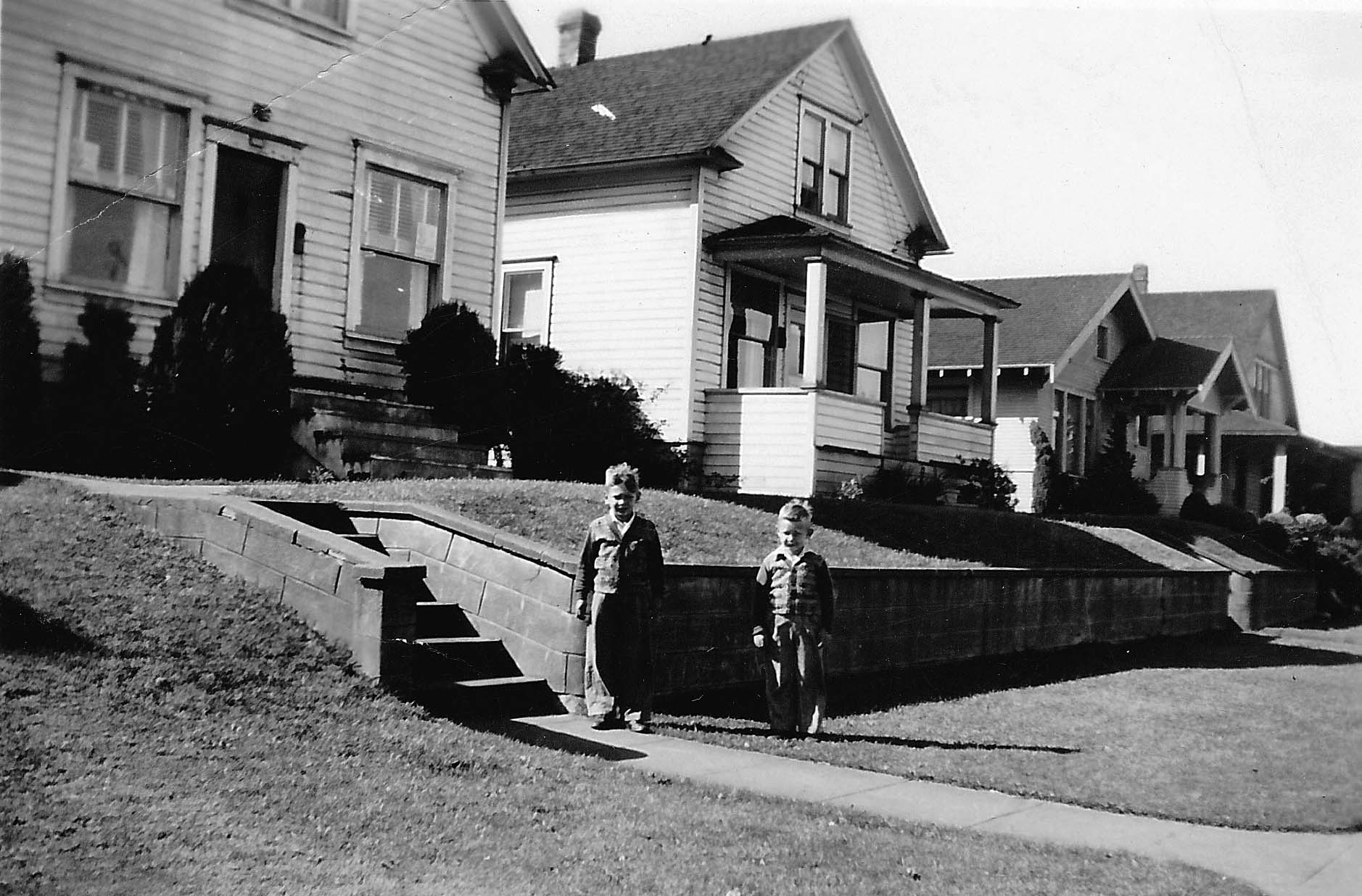 Larry and Len Wold on the 2000 block of Broadway in 1949, including 2020, 2018, 2014, 2010, and 2006 Broadway.
Larry Wold collection
Larry and Len Wold on the 2000 block of Broadway in 1949, including 2020, 2018, 2014, 2010, and 2006 Broadway.
Larry Wold collection
Before Burger King, EHS builds a house
In 1926, students of Everett High School completed this house for Ira Brown, a projectionist at an Everett theater. The Architecture class drew the house plans with negotiations with Mr. Brown. The boys of the Carpentry class built the house except for lathe and plaster, masonry and wiring. The color combinations, arrangement, and furnishings were selected by girls in the Home Economics, Art and Clothing classes. Mr. Brown painted the house.
End of walking tour
We hope you enjoyed your walking tour of the Bayside neighborhood! For more tours, see Historic Everett walking tours. Write us below if you have comments, more history, or questions.
Historic Everett home page
Contact us